Maja Voje's Blog, page 5
February 14, 2025
7 Free Tools from Product Management Toolbox to Drive 10x Impact on Your Business
Dear GTM Strategist!
It is no secret that I have learned more useful stuff from Product Managers than from my native Growth background when I was writing the Go-To-Market Strategist book.
Meeting knowledgeable product leaders (all of them very super kind and helpful) has added so much value to developing the GTM Strategist method we use today to get profitable traction fast. And today, we celebrate their contribution to GTM.
Meet one of my favorite people in the product space, . In my view, Paweł is like a superstar to PMs. He shares insights and resources with nearly 100K readers of the Substack and 200K LinkedIn community.
A while back, we teamed up to bring 5 GTM Principles that are mission-critical for PMs to his audience.
Now, I convinced Paweł (it took me 5 months, but we are here 🤠) to share product management frameworks, mental models, and templates from the product management treasury that are mission-critical for us to understand.
Paweł was more than generous.
Buckle up for a value-packed post. In this Substack article, you will get:
Insights into 7 mission-critical frameworks for your GTM
Implementation guides how to use it from a Senior PM
A treasury of visual assets for your presentations, workshops and reports

This newsletter is sponsored by Attio.
Most CRMs were built for yesterday's businesses. Attio is built for what's next.
Attio is an AI-native CRM built specifically for the next era of companies. It’s flexible, easily configures to your unique data structures, and adapts to any business model - taking you scale from seed stage to category leader.
With Attio, your powerful CRM builds itself in minutes through automatic data sync and enrichment. Then unleash the full power of the platform - from AI-powered automations that handle even your most complex business processes, to our research agent that can help with prospecting and lead routing at scale.
Join industry leaders like Flatfile, Replicate, Modal and more.
Try the CRM that’s built for the future. Start a free Attio trial today.
Paweł, the floor is yours 🙇
Without further ado, let’s dive into actionable tips, frameworks, and templates that PMMs can benefit from:
Product Strategy Canvas (#1 Google)
North Star Framework Playbook
12 Sources of Insights in Product Management
Hidden Risks in Product Management
The XYZ Hypothesis
Eight Prioritization Frameworks
Free AI Agents for Product Marketers
1. Product Strategy Canvas (#1 Google)Product strategy is simple to understand.
But, contrary to common misconceptions, it’s not:
A plan (“We will build X, Y, and Z”).
A goal (“We want to grow by 50% by 2024”).
An ambition (“We want to be the best”).
A business model.
A unique value proposition.
I’d argue that many companies do not have a strategy at all.
A good product strategy:
Defines a vision. Why should your employees get up every day and come to work?
Is a single, integrated set of choices that reinforce each other.
Defines the market and the constraints.
Focuses on customers whom you can’t control.
Has a theory on how to persuade them to do what you want.
Explains the competencies, resources, and systems you need.
Enables you to say no instead of chasing every shiny opportunity.
Can’t be copied. This is essential. The moment you succeed, someone else will try to do the same.
Allows you to formulate hypotheses.
I couldn't find a single product strategy canvas I could recommend.
So, I created a new one based primarily on the insights of industry experts Michael Porter and Roger Martin. It ranks #1 in Google:

Here, you can learn more. No paywall:
Product Strategy Examples: Google Maps, Netflix, OpenAI
Startup Canvas (for new products) vs. alternatives
2. North Star Framework PlaybookThe North Star Metric is a powerful, simple concept every Product Manager and Product Marketing Manager should know. But it’s often misunderstood.
What is a North Star Metric?The term has been popularized by (), also known for coining "growth hacking" while being a growth marketer at Dropbox.
In the Growth Hacking world, North Star Metric:
Is a single metric. The goal is to create focus.
Is easy to understand, enabling everyone to speak the same language.
Is customer-centric. Reflects how customers get value from the product.
Ideally, it ensures the value is sustainable, typically by forming habits.
Represents progress toward vision/mission.
Is quantitative. It relies on numbers, not opinions.
Is actionable. You take action based on how it changes.
Serves as a leading indicator of your long-term business success.
Common MisconceptionsIt's important to clarify what the North Star Metric is not:
A few metrics. While a company may select a few key metrics, referring to them as "North Star Metrics" is a misunderstanding. At the same time, a single North Star Metric is often accompanied by a set of "input metrics."
A metric focused on business value, like LTV/CAC. It misses the essence of customer-centricity. Besides, can your team truly get excited about just increasing revenue?
A strategy. A strategy is a cohesive set of choices, such as a Value Proposition, that reinforce one another and help you to succeed in the selected market. Your NSM must align with your strategy. And it's one of the strategic choices.
Recommended ClassificationI've come across various attempts to classify North Star Metrics. The best one I've found was proposed by Amplitude. Depending on the game you are playing, you want to focus on:
Attention: How much time do your customers want to spend using your product? The time and recurrent use of a product can indicate the value people derive from it.
Transaction: How many transactions do your customers make in your product? Your goal is to help customers find the right product quickly and easily.
Productivity: How efficiently and effectively can someone do their work? Your goal is to help customers with specific tasks.
Identifying the game you are playing is the first step toward finding your North Star Metric.
Free North Star Framework PlaybookI summarized all key insights on the North Start Framework in my free playbook, The North Star Framework 101 (13 pages, PDF).
 The North Star Framework 101
The North Star Framework 101You can download it for free here:
Download The North Star Framework 101
3. 12 Sources of Insights in Product ManagementWhen working on a product, a common piece of advice is to “just talk to customers.”
Talking to customers regularly is super important for any product team. But the best product teams leverage insights from multiple sources.
Here is my mental framework and 12 ideas you can start using tomorrow:
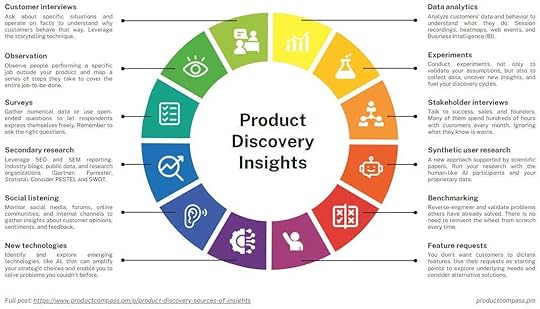
In particular:
Data and product analytics help you understand what customers do in your product. Customer interviews help you understand why they do it.
Stakeholders (like sales, support, or customer success teams) spend countless hours with customers and can share insights you might not discover otherwise. Ignoring their knowledge and starting discovery from scratch is a common mistake among new product teams.
Feature requests can help you pinpoint underserved needs. Product teams often dismiss them by saying, “customers don’t know what they want.” You don’t have to build everything customers ask for, but these requests can spark valuable discussions. And frankly, some feature requests, like importing files from Google Drive, are no-brainers.
Benchmarking is another valuable tool. While we should not obsess over competitors, studying how others tackle similar challenges can help you validate ideas, avoid pitfalls, and find new opportunities. The key is to learn from competitors without simply copying them.
By pulling insights from multiple sources, you maximize your impact as a PM/PMM.
4. Hidden Risks in Product ManagementI’d argue that product management is, at its heart, about managing risks.
We want to identify and test the riskiest assumptions as early as possible to get maximum validated learning with minimum effort.
Product teams usually focus on the well-known framework: Value, Usability, Viability, and Feasibility. Some simplify it to Desirability, Viability, and Feasibility.
But I’ve seen countless products and initiatives fail for different reasons.
Depending on the context, three other critical risk areas to consider.
Risk area 1: Go-to-marketAsk yourself:
Can we market it?
Do we have the required channels?
Can we convince sour customers to try or buy it?
Is this the right messaging for this channel?
Is this the right time?
Is this the right way to launch it?
Risk area 2: StrategyAsk yourself:
What needs to be true for this strategy or business model to work?
Can we ensure our competitors can’t copy our strategy?
Have we considered external political, economic, legal, technological, and environmental factors?
Risk area 3: TeamsAsk yourself:
How well will the team work together?
Do we have the right people?
Do we have the right tools?
Will the entire team stay with us long enough?
What will happen if someone gets sick?
The Extended Risks ClassificationHere, you can download my extended risk classification to help identify possible reasons for failures:

You can read more about managing risks in product management and experiments you can perform using a 30-day trial at the end of this post.
5. The XYZ HypothesisOne of my favorite pieces of advice for working with new products comes from The Right It by Alberto Savoia. His key insights:
Insight 1: Ask for Skin-in-the-GameOver 80% of new products fail. Alberto Savoia calls this “the law of market failure”:
“Most new products will fail in the market, even if competently executed.” – Alberto Savoia, The Right It
The main reason? People build things nobody needs. And many of these failures can be avoided.
When it comes to market validation, opinions (“It’s awesome”), encouragements (“Go for it!”), and comments and likes on social media are useless.
Because “It’s much easier to open your mouth than your wallet.”
Your market research must include “Skin-in-the-Game Points,” which Alberto Savoia defines as:
 Source: The Right It, Alberto SavoiaInsight 2: Collect Your Own Data (YODA)
Source: The Right It, Alberto SavoiaInsight 2: Collect Your Own Data (YODA)In your market research, don’t rely on data collected by others (Other People's Data, or ODP for short).
The fact that others succeeded with similar ideas doesn't mean you will also succeed. Similarly, the fact that others failed with similar ideas doesn't mean you will fail, too.
A good example is what Tesla did with the Tesla Model 3.
Before 2016, Honda, Ford, and Toyota failed. If Elon Musk relied on their data, he would have never built the Tesla Model 3. But he decided to collect his own data (Your Own Data, YODA for short).
On April 1, 2016, Elon proposed a mass-market, affordable electric car and started collecting orders. In 24 hours, he received more than 115,000 orders. In October 2016, Tesla held close to $700 million in customer deposits.
That’s a lot of skin in the game. $35 billion Skin-in-the-Game points, to be precise. Now, they could go forward with building the first gigafactory.
Insight 3: The XYZ HypothesisMany formulate a Market Engagement Hypothesis, which combines the fundamental premise behind their idea and how the market will engage with it.
Unfortunately, those hypotheses often look like this: “Many people will build a fast, electric car at a reasonable price.”
To test the idea, we must “say it with numbers,” for example: “At least 5% of mid-size luxury sedan buyers will buy a Tesla Model 3 in 2019 for $40K or more.”
The basic form of the XYZ hypothesis is “At least X% of Y will do Z,” where:
X% represents the percentage of your target market.
Y represents your target market (e.g., “mid-size luxury sedan buyers”).
Z represents how they will engage with your product.
You can learn more about the XYZ Hypothesis from this video:
In his book, Alberto focuses on market engagement. Other hypotheses, like hypotheses related to feasibility or specific features, might have a different form.
You can learn more about experiments to perform using a 30-day trial at the end of this post.
Insight 4: Test Your Ideas by PretotypingAlberto uses the term “pretotyping” to emphasize the importance of testing an idea without building a product, as opposed to building working “prototypes.”
Here, you can download a free PDF with nine basic prototyping techniques:
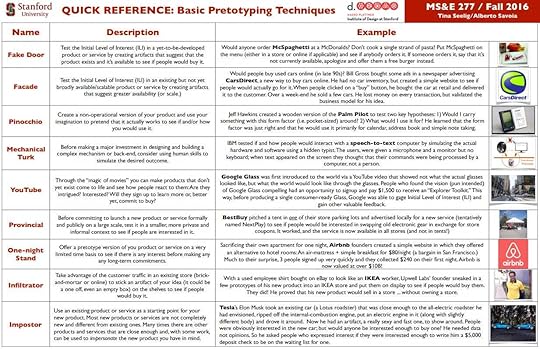 Source: Basic Pretotyping Techniques, Alberto Savoia
Source: Basic Pretotyping Techniques, Alberto SavoiaBonus: a free e-book (90 pages, PDF/Kindle): Pretotype It by Alberto Savoia.
Another approach to test your product ideas is AI Prototyping. A free step-by-step post with two case studies (no paywall): AI Prototyping: The Ultimate Guide For Product Managers.
Thanks for reading GTM Strategist! This post is public so feel free to share it.
6. Eight Prioritization FrameworksIn product, we can’t do everything. And we can’t be everything to everyone.
It’s essential to focus on a few things that actually move the needle.
Here are my eight favorite prioritization frameworks with free templates:
 Eight Prioritization Frameworks in Product Management
Eight Prioritization Frameworks in Product ManagementFramework 1: Eisenhower Matrix
Useful for prioritizing tasks. Free template (Miro).
Framework 2: Opportunity Score by Dan Olsen
Useful for prioritizing opportunities (customer needs, pains, desires). See my introduction (PDF) and the official Dan Olsen's template (PPTX).
You can learn more from What Is Product Discovery (no paywall).
Framework 3: Impact vs. Effort (2x2)
Useful for prioritizing tasks and initiatives. Free template (Miro).
Framework 4: Risk vs. Reward
Useful for prioritizing initiatives. Free template (PPTX).
Framework 5: Kano Model
Originally developed to prioritize features. Please remember to prioritize customer needs, not solutions. Free template (Miro).
Framework 6: Weighted Decision
Useful for prioritizing decisions when there are many factors to consider. Free template (XLSX)
Framework 7: (R)ICE Framework
Those frameworks are useful for prioritizing initiatives and ideas, considering not only the value but also the effort and risks. Free ICE template (XLSX) and free RICE template (XLSX).
Framework 8: Assumption Prioritization
A canvas created to help you decide which assumptions to test. Free template (PPTX).
You can learn more from this free post: Assumption Prioritization Canvas: How to Identify And Test The Right Assumptions.
7. Free AI Agents for Product MarketersRecently, I created a set of free AI Agents for Product Managers and Product Marketers:
PRD Generator: Helps you generate Product Requirement Documents
Product Strategist: Helps you develop a winning product strategy (aligned with point #1)
Assumption Identifier: Helps you identify high-risk assumptions (aligned with point #3)
PM Resume Reviewer: Provides a detailed review of your PM/PMM resume
Product Trio Ideation: Helps you explore diverse product ideas
Coming soon are more agentic capabilities:
Deep Web Research (e.g., competitor analysis, market sizing)
Autonomous, Multi-Step Reasoning (e.g., market research > ideation > assumptions)
 AI Agents for 10X Product ManagersThanks For Reading My Guest Post!
AI Agents for 10X Product ManagersThanks For Reading My Guest Post!Subscribe to The Product Compass Newsletter to dive deeper:
100+ posts (discovery, metrics, experiments, AI product management)
600+ actionable resources (books, videos, templates, playbooks, and courses)
Including my three courses:
Continuous Product Discovery Masterclass
From Strategy to Objectives Masterclass
Product Innovation Masterclass
And premium posts, such as:
The Ultimate Experiments Library
The Ultimate List of Product Metrics
How to Manage Risks as a Product Manager (deep dive)
Top 55 ChatGPT Prompts for PMs
How to Build Simple SaaS And Test Your Ideas Without Coding
Introduction to AI Product Management
Jobs to be Done Masterclass with Tony Ulwick
The Ultimate Guide to Customer Interviews
As a member of the GTM Community, you get a 30-day trial with full, unrestricted access to my content. This offer is valid until Feb 28, 2025:
No hassle. If you forget to cancel, every subscription has a 30-day money-back guarantee 🙌
A huge shoutout to Maja for building the #1 resource on GTM and creating such an insightful community. I learned a lot from her work, and I’m grateful to be part of this space! ❤️
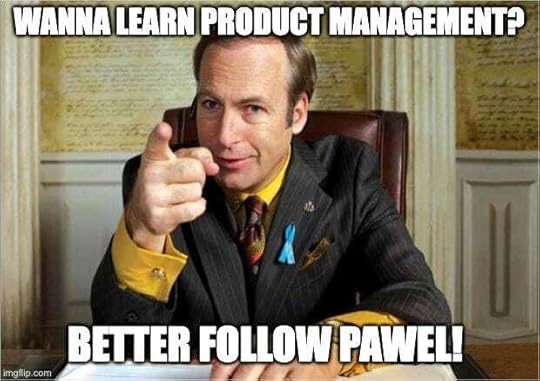
Wow, isn’t Paweł a fountain of knowledge and insights?
Thank you so much for this collaboration - you are a legend!
Definitely give him a follow & power up your product management knowledge, even if that is not your job title. It is worth the effort because it brings you closer to the product team (easier communication and collaboration) and gives you valuable knowledge and skills for launching your products.
Now let’s get these insights to practice - I will start with the AI agents because I am an AI geek. You?
My new product: GTM Checklist with AI Prompts ✨This week, I launched the Go-to-Market Checklist with AI Prompts. It consists of 100+ tasks to get new customers for tech products in under 14 days.
It is an upgrade of my best-selling step-by-step checklist that will get you from launch planning to scaling profitably and faster - now with the help of AI.
In the launch week, you can grab it at a special price.
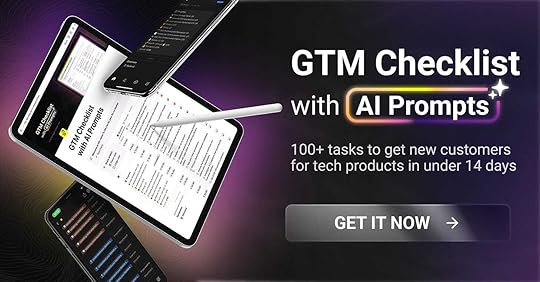
February 7, 2025
Enterprise GTM Unpacked
Dear GTM Strategist,
An enterprise cannot “just move fast and break things.” I am often asked how go-to-market strategies and decisions look at large and complex organizations.
To hear this firsthand, I invited Amy Mitchell, Principal Product Manager at Dell and author of the "Product Management IRL" Substack, to share her invaluable go-to-market insights. With over 30 years of experience at leading enterprises such as Cisco, Hewlett Packard, Alcatel (Nokia), and Zerto, we are in great hands to navigate the complexities and best practices of enterprise GTM.
In this Substack, you will learn:
The specifics of doing GTM in the enterprise environment ($1B+ yearly revenue)
Best practices on how to navigate the enterprise specifics as a GTM leader with a strong emphasis on collaboration, strategy, and sales enablement
What everybody should know about sales enablement and why it makes such a massive difference
3 case studies for PMs and PMMs in large enterprises
And I had to ask: “How can a small business have a fair chance to shake hands with an enterprise client even in the earlier GTM stages”?

Do you handle thousands of support interactions every month?
Tidio is opening access to their AI customer support agent for the GTM Strategist subscribers. You can now automate up to 64% of your emails and live chats with AI—completely free, with no commitment for the first 3 months. Tidio’s team will help you set up Lyro, their AI agent, and include up to 10,000 conversations during this trial. You can add it to your existing support platform or use Tidio’s complete suite.
This post is sponsored by Tidio. Tidio’s AI agent, Lyro, guarantees a 50+% resolution rate with hassle-free setup and no strings attached.
Installed by over 300,000 businesses, Tidio is a complete customer service platform that consolidates your support requests from live chat, email, and social media into one dashboard.
Now, let’s hear it from Amy Mitchell:
Picture this: you're leading a global enterprise's go-to-market strategy for a new feature. In the smaller organizations you've worked with, you owned the end-to-end GTM process. Decisions were streamlined, and execution moved quickly.
The differences aren't just about scale; it's about navigating a more intricate system of roles, processes, and priorities. To bring the creativity and agility of smaller organizations into the enterprise world, you first need to understand the structure and strategies that global enterprises use in GTM.
However, in a large enterprise, the dynamics are different. Layers of stakeholders, complex approval chains, and diverse regional needs can feel like barriers to your tried-and-true methods.
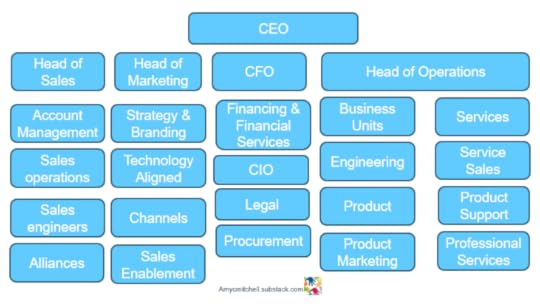 The distributed organization affects GTM in large, high-tech enterprisesWhy GTM in Enterprises Feels Like a Different World
The distributed organization affects GTM in large, high-tech enterprisesWhy GTM in Enterprises Feels Like a Different WorldA large enterprise typically has an annual revenue of $1B+. Besides the high revenue, there are other differences in the enterprise environment:
Large scale: more employees, multiple divisions, broad geographic presence. Leading to complex organizations and sophisticated management structures.
Significant market share: Major product lines that command a significant portion of their market.
Substantial financial resources: investing in research and development, marketing, and expansion.
Brand recognition: high brand recognition and loyalty. Products are widely known and trusted by customers and the market.
Corporate Social Responsibility: priority on initiatives that support environmental sustainability, diversity, and community development.
In this enterprise world, these differences impact the GTM teams significantly:
Regional differences: Country leadership and metrics with dependencies on headquarters
Sales organization: Account management is divided into territories, verticals, and named accounts
Field CTOs and Sales engineering: technical giants providing thought leadership and driving long-term growth
Strategic partnerships: with top-tier consulting firms for expertise and insights to drive growth and competitive advantages
Marketing budgets: allocated to channels, campaigns, business units, and geographic regions. Measured as a percent of revenue evaluated by return on investment
Selling breadth: extensive product catalog with complex sales incentives
Product teams: product managers and product marketing managers for every product
This means GTM teams are dealing with multiple organizational layers and multiple cross-functional teams.
Collaboration Structures for GTM in Large EnterprisesDue to the scale of large enterprises, there is a hierarchy of GTM. At the bottom are the products that the organization sells. Next comes the product lines and major messaging to the market. At the top are the organizational and branding positions.
Adjacent to the organizational hierarchy of outbound marketing is the sales organization. Sales is a key user of the GTM materials. However, sales are not organized like marketing. Sales are organized to match the key customer segments that the organization is targeting.
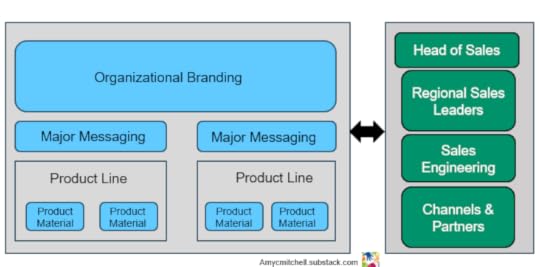
Marketing initiatives in large enterprises follow two major categories:
Corporate marketing goals supporting brand feelings and public perception of the enterprise
Technology initiatives aimed at launches or targeted growth of a customer segment
A fully staffed senior team of branding and marketing specialists generally handle corporate marketing initiatives. On the other hand, the technology initiatives come up through the product teams distributed in the business units in the organization.
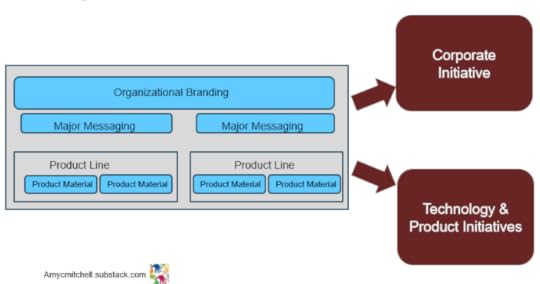
In both cases, virtual teams form around the initiative to drive it to closure and measure the ROI of the investment. The desired outcome of the initiatives is to catch the eye of potential customers which leads to future sales.
While corporate marketing is fairly straightforward and handled by a dedicated team, how does a large enterprise control its technology and product initiatives? Budgets and policies are the way to do this.
Budgets are top-down and cover marketing and product funding. Annual budgeting is driven by current and future sales.
Policies cover any outbound communication. Consistency of messaging and partnering is mandatory as well as perceptions in the global community.
GTM initiatives in large enterprises are often driven by self-managed virtual teams, bringing together key stakeholders from different functions. These teams typically consist of:
Product Managers (PMs): Focus on product launches, ensuring their products are successfully developed and introduced to the market.
Product Marketing Managers (PMMs): Oversee corporate marketing strategies, budgets, and positioning to align products with broader business objectives.
Sales Enablement Leads: Bridge the gap between product and sales, equipping sales teams with the resources, training, and insights needed to close deals effectively.
Each role plays a crucial part in the success of enterprise GTM execution, ensuring alignment between product development, marketing strategy, and sales effectiveness.

How do these GTM virtual teams operate successfully in a large enterprise?
Large enterprises have sales enablement leads, who are the link between product, marketing, and sales and are crucial for winning go-to-market efforts. Sales enablement leads are part of the marketing organization or they are part of sales leadership. Here is more on sales enablement by Salesforce.
What Sales Enablement Does in Enterprise GTMThe sales enablement team in enterprises is key to connecting product information in a meaningful way to sales. Quota-carrying account teams need thoughtful insights from the sales enablement team to develop opportunities for long-term happy customers.
Timely information on customer segments and competition that is tuned to sales success can free up salespeople to build relationships with potential customers. The sales enablement teams are key to connecting product and marketing material to the sales teams.
Why can't the sales teams adapt product and marketing material to fit their work with prospective customers? While good product documentation and marketing materials are important, these materials rarely link customer problems to solutions that work in their environment. Sales teams need business and technical information for the different audiences they meet.
In B2B, there are users to help and buyers to satisfy before closing a sale. On the typical B2B product sale, the account team needs to show how your product responds to their problem. Some of the audiences that B2B sales teams contact are:
IT users who need to be more responsive
CIOs and IT directors who must deliver cost reductions
End users of the enterprise
Procurement managers who drive contract terms
System architects who need to scale the enterprise resources
Material that shows the problems of these different audiences and links to solutions saves time to build relationships with key people in the potential customer.
 What Are the Key Sales Enablement Activities?
What Are the Key Sales Enablement Activities?Successful sales enablement teams have organized their work and timelines to anticipate the needs of account teams calling on large enterprises. A few key activities that sales enablement teams drive are:
Filling content gaps - connecting product and marketing materials to verticals and regions
Messaging across regions - tailoring content to language and regional practices while keeping consistent messaging
Rapid communication channels - ordering guides, sales pages, targeted training maintained to meet evolving customer needs
Ongoing sales support - a clearinghouse for sales opportunities plus sales decks and frequently asked questions and answers (FAQs)
Successful sales enablement teams have organized regionally to work closely with sales and customers. Additionally, sales enablement is tuned into the product development cycle. They play a key role in anticipating sales needs and keeping the pipeline full of customer opportunities.
Best Practices for GTM in Large EnterprisesThe benefit of the virtual team with PMs, PMMs and sales enablement is navigating the organizational layers and cross-functional demands of large organizations. Large enterprises have developed a variety of ways to generate sales depending on their market and product offerings.
Despite the differences from enterprise to enterprise, I’ve found three best practices that successful virtual teams use.
 GTM Best Practice 1: Align on GTM strategy early in the product development cycle
GTM Best Practice 1: Align on GTM strategy early in the product development cycleAgreeing on the GTM strategy between the virtual team is a game changer for product success.
Often the PM wants prominent communication about their product benefits. While the PMM is focused on supporting the broader messaging and positioning. Sales enablement sets a strategy with these key elements:
Positioning of the product relative to the rest of the products in the organization
Timing of launching and other outbound activities
Messaging that fits in the corporate brand and initiatives
Business metrics that align with organizational business objectives
Frequently, stakeholders are involved in settling strategy debates because there are tradeoffs between positioning and business impacts. For example, when launching new features, a mid-tier product could encroach on a top-tier product market segment.
The GTM strategy sets the budget and plans for the GTM activities leading up to the launch.
GTM Best Practice 2: Optimize Sales Productivity with Sales OperationsThe sales operations team is focused on minimizing sales friction. In a large enterprise this team is crucial for:
Handling commerce tools to book orders and recognize revenue
Track the sales pipeline through CRM tools (like Salesforce) to forecasting and sales management
Automation and smooth handoffs through the sales cycle
A good sales operations team keeps sales teams focused on customers!
Execution of the GTM strategy depends on the sales enablement plan. The GTM virtual team develops materials and training to deliver the sales enablement plan.
A key part of the sales enablement plan is processing new customer orders at scale. The kinds of materials the GTM virtual team provides for sales operations are:
Sales motion that is easy to follow from first customer contact through booking the order
Sales compensation that is automatically tied to the products the customer orders
Ordering guidelines that are maintained based on sales feedback
The key deliverables for sales operations are:
A sales training slide deck that covers the sales motion, product overview, and sales compensation
An ordering guide with product use cases, ordering examples and where to go for help
The sales enablement team trains the sales operations team on deal handling ahead of the product launch.
GTM Best Practice 3: World-class sales support in placeSales teams that solve customers’ problems with their solutions must:
Know every product in their sales targets - depending on the sales organization, each sales team can be handling 100s of products
Know their customers deeply - sales team relationships are important for budgetary insights, growth plans, and access to decision-makers
A winning GTM strategy prioritizes providing sales support information and people across the enterprise to support.
Enterprise-scale deals involve multiple products and services. The sales support teams have a deep understanding of customer use cases and they adapt the marketing materials into solutions for potential customers.
The GTM virtual team develops these key materials:
Solutions for pre-sales support: customer drivers for the solution, competitive options, and product overview
Technical white papers: cost savings calculations, reference architectures, compliance matrices, and solution overviews
FAQs and Proposal responses: details that customers need to spend money on your product such as compliance, support policies, access to the product, licensing, expansions, white papers, and validated designs
Enhancements and customization options: how to handle objections and variable options in the product
The material is updated frequently to cover product updates and new reference architectures.
The GTM virtual team delivers product materials that sales can use to find answers. This is some of the most creative material in the organization!
Conclusion: Mastering Enterprise GTM with Collaboration and StrategyGTM in a large enterprise requires a structured, multi-layered collaboration of a global business. Success doesn’t come from a single function—it results from product managers, product marketing managers, and sales enablement leads working together to align strategy, messaging, and execution.
By adopting best practices such as early GTM alignment, reduced sales friction from sales operations, and world-class sales support, virtual teams can drive impactful go-to-market initiatives. The key is to leverage cross-functional collaboration and ensure sales teams have the tools they need to win deals.
Whether you’re launching a new feature or driving a major strategic initiative, understanding and mastering these enterprise GTM principles will set you up for success in even the most intricate organizations.
After navigating through the enterprise GTM landscape, I had to ask Amy a question that is probably keeping a lot of us on our tippy toes when reading this valuable article: “How can a startup successfully sell to an enterprise?”
For a startup that enables sales of an enterprise product, the startup needs to work closely with the enterprise sales team to close joint customer deals. In parallel, the startup needs to contact the corresponding product leaders to provide customer feedback on the joint solution.
For example, suppose you are a startup that provides a data protection service for enterprise storage products. One of your sales teams has a customer using your product with a leading enterprise storage vendor. Your sales team begins working with the enterprise sales team. This leads to meeting the enterprise partner team followed by meeting the storage product leadership team.
Why does the big enterprise want to talk to a startup? Two reasons:
The startup can bring new customers to the enterprise - Reason: enterprise sales teams can’t spend time developing a small opportunity.
The startup can bring concentrated insights on customers - Reason: enterprise product leaders have limited time with customers and miss key insights.
For a startup that sells to an enterprise without a joint customer, then the startup needs to join the enterprise’s partnership program. And the startup needs to get the users in the enterprise to try their product. Before attempting to get enterprise users, the startup needs to show there is no security or compliance risk to the enterprise. You can see some examples of partnership programs at Microsoft, AWS, and Dell.
Let’s suppose you have an AI utility that can extract speech-to-text from customer service calls. This utility can save time handling incoming support calls by routing the call to the right expert in the enterprise. You would need to provide a copy of your utility to the enterprise so the enterprise call data is not exposed outside. You also join the enterprise partner program.
Why does the big enterprise want to talk to a startup about a cost-saving utility?
The enterprise leaders are under intense pressure to modernize and find cost savings - a startup has examples of real cost savings
The startup offers a low-risk way to demonstrate costs savings - the startup has covered security and privacy concerns
Wow - just wow.
Where there is a vision, there is a path.
Thanks so much, Amy, for sharing your knowledge and best practices with us. 💜
If you would like to learn more about Product Management in larger organizations, follow Amy Mitchell on LinkedIn and subscribe to her Substack Product Management IRL.
As Amy pointed out, world-class support is one of the best GTM practices. So let me remind you of a special offer for my subscribers to try Tidio’s AI customer support agent, Lyro, completely free for 3 months. This includes up to 10,000 conversations and full implementation support.
Let’s go to (the enterprise) market!
Maja
January 31, 2025
Tally’s Bootstrapped Journey to 500,000 Users and $160K MRR
As the renaissance of AI makes entry barriers as low as ever and robbs established companies out of product-market fit, it is more important than ever to learn GTM from companies that have made it “against all odds.”
Meet Tally - the simplest way to create forms for free. In four years, they acquired 500,000 users worldwide and reached $160K in Monthly Recurring Revenue (MRR) in a rather crowded space of SurveyMonkey, Typeform, Google Forms etc.
 Tally’s impressive MRR growth
Tally’s impressive MRR growthI found their story refreshingly relatable since the cofounders are a couple (I work with my husband too), the company is registered in Belgium 🇧🇪 - there is hope for EU tech 🤠, the company bootstrapped a team of 4 experts, not another Harvard alum, prev Data Scientist at Meta Silicon Valley investment-backed wunderkind.
How cool.
But you are here to get tactical. What can you learn from Tally’s journey?
In this Substack post, we will deep-dive into some of their go-to-market secrets behind their beautiful 🏒 growth curve. You will learn some extremely tactical takeaways that you can apply to your GTM, such as:
Use manual outreach on platforms like Product Hunt, Reddit, and X (Twitter) to drive early traction and directly engage target users.
Build growth loops into your product by leveraging free-tier branding (e.g., “Made with Tally” badges) to turn users into advocates and drive organic acquisition.
Disrupt pricing norms with bold strategies like offering unlimited free features to attract users and upsell premium tiers later.
Prioritize continuous feedback loops with power users through direct channels like Slack or community forums to refine your product.
Build in public to humanize your brand, foster trust, and cultivate an engaged audience eager to support and promote your journey.
Optimize for quick time-to-value by eliminating friction in onboarding, enabling users to experience your product’s core value without barriers.
I invited cofounder Marie Martens to share Tally’s go-to-market journey. She was so generous with insights and numbers 🙏. She covered all the stages of GTM:
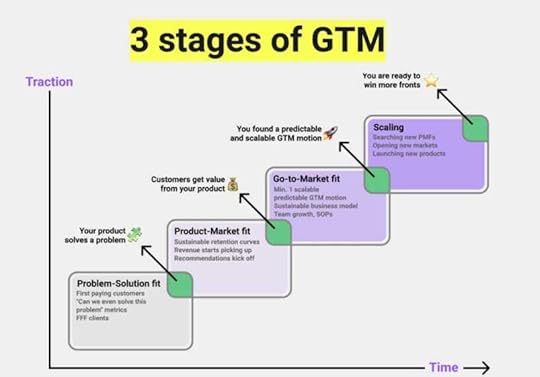
Let’s hear it directly from Marie:
Founding Story and VisionOur leap into entrepreneurship during 2020 and early challenges faced.In late 2019, I and my partner and co-founder Filip Minev decided to chase our dreams. I spent 10 years in B2B marketing, while Filip (full-stack engineer), had recently sold Delta—a crypto portfolio app he built—to eToro.
 Tally’s co-founders Marie & Filip 💗
Tally’s co-founders Marie & Filip 💗We started building a product for the growing influencer marketing industry while living as digital nomads. Our venture, Hotspot, would be a platform connecting hotels with travel influencers for collaborations. To validate the idea, we reached out to 1000 potential hotel partners and found 100 that we’re interested in the idea (using a Google Form). What started as a side project grew into an MVP by early 2020, with an increasing number of hotels and influencers joining the platform. I quit my job, and we flew to Bali, planning a stopover in Bangkok.
However, as soon as we landed in Bangkok, the pandemic struck. Countries began locking down, customers started canceling or pausing subscriptions, and flights were being canceled. After just one week, we had to return home and enter lockdown. Six months later, with no sign of recovery in the travel industry, we decided to pivot to a new project.
 On our way back to Belgium after one week
On our way back to Belgium after one weekDuring a brainstorming session, we started talking about forms. We both had used various form builders in our previous roles but never found one they truly enjoyed. While Typeform was beautiful, it was too expensive—especially for indie hackers. Google Forms was powerful but lacked design appeal. Around this time, we also started using Notion and had an insight: if Notion could make note-taking fun, why couldn't we do the same for forms? Why not make forms both fun and free? That's how Tally was born.
Marie and Filip’s vision to make form-building simple, fun, and accessible.We set out to build Tally, the simplest way to create forms, for free. We wanted to create a powerful form builder that lets anyone make any type of form without spending a fortune. We believe you shouldn't pay more just because your forms convert. So we introduced something new—a concept no one had tried before:
We abandoned volume-based pricing, offering unlimited forms and responses for free
We created a modern form-building experience—no drag-and-drop, just a beautifully simple interface that works like a text document
 Stages of Tally’s Growth1) 👫 Problem-Solution Fit: Getting the first users
Stages of Tally’s Growth1) 👫 Problem-Solution Fit: Getting the first usersTwo months after starting to build our MVP, we launched into an intensive cold outreach phase. Our strategy began with our immediate network of friends and family, then expanded to Product Hunt. They identified and personally reached out to founders, designers, marketers, and product managers who had upvoted similar no-code tools. We sent thousands of messages and had a pretty high reply rate of around 10%.

This manual, custom outreach continued for 6 months. The most engaged users joined our Slack channel (which has since grown to 4,000 members), creating a tight feedback loop that guided our product development.
Key strategies we used:
Analyze Product Hunt for users engaging with similar products
Connect with established makers for feedback and validation
Actively participate in relevant Slack communities
Monitor X conversations about competitor products using Tweetdeck
Engage in discussions on Reddit, Quora, and Indie Hackers
Share our founding journey publicly to build a founder audience
2) Getting to Product-Market Fit 🚀 Launching on Product HuntIn March 2021, we felt ready to launch on Product Hunt. We had built a small community of 1,500 users and released crucial features that would help us compete with other form builders. The launch doubled our user base from 1,500 to 3,000 users and was instrumental for kickstarting product-led growth.
This checklist contains everything we did to prepare for a successful launch.
On September 19, 2023, we launched Tally 2.0 on Product Hunt, marking three years since our initial debut on the platform. The primary objective was to attract new users and showcase the enhanced features and redesign of Tally 2.0.
It proved to be a highly competitive day, with three products each receiving over 1,000 upvotes. Despite the competition, we secured the top spot as the #1 product of the day.

Following the launch, Tally was recognized as the #1 Product of the Day, Week, and Month. Additionally, we received a Golden Kitty award for the best bootstrapped product.

Traffic and Exposure: The launch day attracted 9,800 visitors to Tally’s homepage, marking the second-highest traffic day ever at that stage for Tally. Product Hunt referrals accounted for 3,900 unique visitors post-launch, with a peak of 1,400 on launch day. Tally was also featured in Product Hunt’s Daily and Weekly Digest newsletters, as well as The Verge’s Installer newsletter, bringing in an additional 1,700 unique visitors.
User Growth: The launch led to record-breaking user signups (at that stage), with 766 new users on launch day and 785 the following day. In the two weeks post-launch, we got 4,400 new users per week, a 91% increase from the typical 2,300 weekly signups.
3) 📈Go to Market fit: Product-led growthYou can learn more about Tally’s Product Hunt launch results on our blog (screenshots and results inside): https://blog.tally.so/product-hunt-launch-results/
We run a product-led business where user acquisition, conversion, and retention are driven by our product. A major factor in our growth has been free product, which plays a central role in our success.
Today, most people discover Tally through our 500,000 users. The best advertising is done by happy users, and our satisfied customers help spread the word.
Beyond word of mouth, our product is our main acquisition channel. With Tally being largely free, free forms display a “Made with Tally” badge, boosting visibility, attracting new users, and converting them into paying subscribers.
Out of 35,000 new users a week, 40% come from “Made with Tally” badge, 30% from Search, 15% Direct, and the remaining share is a combination of Social Media (LinkedIn, YouTube, Reddit, Twitter, Facebook), Product Hunt and occasional partnerships.
Our growth flywheel works like this:
Free access lowers the barrier to trying Tally, creating positive word of mouth.
Free users display a “Made with Tally” badge, turning them into the product’s biggest promoters.
About 2% of free users upgrade to Tally Pro, driving revenue.
Key components of our strategy include:
Simplicity: A frictionless UX, simple pricing, and clear communication.
Freemium Model: A generous free tier without trials or paywalls.
Quick Time-to-Value: Users can create, publish, and share forms without signing up or entering payment details.
Self-Service: A user-friendly interface with resources like FAQs and guides.
Virality: The Tally badge on forms spreads the product organically.
Customer Advocacy: By prioritizing customer support, happy users become loyal promoters.
This approach has allowed us to grow organically, using our product as the engine for both acquisition and retention.
 Tally's growth flywheelChallenges and Iterations in the Scaling StageScaling Customer Support
Tally's growth flywheelChallenges and Iterations in the Scaling StageScaling Customer SupportOffering a free product comes with challenges—chief among them is supporting a growing base of free users. We always chose to prioritize customer support, initially responding to Slack messages, emails, and Twitter DMs within the hour. This approach allowed us to deeply understand our users’ needs through direct feedback. However, as the user base grew, maintaining this level of personal support became unsustainable.
To scale customer support, we implemented the following strategies:
We created a comprehensive help center from scratch using Notion, documenting all answers to support tickets (check out Filip's thread if you're interested in the tech side of this project).
By keeping the product intuitive and easy to use, we minimize support requests.
The Slack group was shut down for new users as it had turned into a 24/7 chat support line.
We adopted Missive as a shared inbox tool to manage incoming queries more efficiently.
Our first hire was a customer support agent from the Tally community, bringing passion and familiarity with the product.
We launched an expert program, enabling users to engage experts for specialized assistance.
We introduced support boundaries for certain technical features (such as writing custom CSS) to limit support expectations.
We stopped replying across all channels by introducing a support ticket form (built with Tally) to streamline and qualify support requests.
We introduced a feedback board for users to submit suggestions and upvote features (which were previously tracked manually with added context).
 Growing the team
Growing the teamWhen we first started building Tally, we imagined a fully remote, asynchronous team with the freedom to balance work, life and travel.
But then reality set in: running Tally demands all our energy, deep focus, and consumes every hour of the day. The dream of flexibility and travel didn’t last very long. Adding a year of pandemic lockdowns, two kids, and four years of working from home to the mix, work-life balance became almost impossible as the lines between work and personal life blurred completely.
Since our local team was just Filip and me, and we didn’t have the budget for an office at first, working from home was the default. But, in our home-based bubble, it became harder to stay productive, disconnect from work, and avoid burnout. Over time, it became clear we needed a change. Besides balancing work and life, bridging communication with our amazing remote freelancers, and building a team culture were all growing challenges.
Finally, we decided to find an office—and we discovered the perfect space at Ghent’s Wintercircus. We’ve been lucky to work with a talented pool of contractors, but with our dream office in place, we felt ready to hire an in-house team and build together in person. That’s where Wouter (Full-Stack Engineer) and Frederik (Customer Support) came in. With a small but mighty team of 4 we’re ready for our next chapter!
 Tally team in 2024Battling scammers
Tally team in 2024Battling scammersBecause Tally is mostly free with no limits on form submissions, it also attracts abusers who engage in malicious activities: creating phishing forms for example. We don't want to compromise on our free tier by introducing limits, so a growing amount of our time started going into blocking scammers and finding new ways to prevent abuse. We’ve managed to automate this process, but it still requires manual moderation to be able to keep scammers at bay.
Takeaways for GTM StrategistsDo Things That Don’t Scale: Manual cold outreach played a crucial role in kickstarting Tally’s product-led growth. Personal, hands-on efforts can make a big difference, especially in the early stages.
Talk to Your Users: Establishing a continuous feedback loop is essential. Engaging with users ensures you’re building a product and creating content that truly aligns with their needs and desires.
Prioritize User-Centric Design: Tally’s simple, intuitive approach to form building eliminates complex drag-and-drop interfaces, opting for a straightforward, text-based experience. This design philosophy enhances user adoption and satisfaction.
Adopt an Innovative Pricing Strategy: Tally disrupted the norm by offering unlimited forms and responses for free, challenging traditional volume-based pricing models. This bold move broadened accessibility and won over users.
Build in Public: Transparency about Tally’s journey helped cultivate a personal audience, foster trust, and build strong advocacy. Sharing your progress openly can create a loyal and engaged community.
Navigating the futureWe’re not chasing shiny new strategies; we’re focusing on what works for us: building a tool people genuinely love to use. It may sound simple—even boring—but simplicity, a generous free plan, and a personal touch are the core values that make Tally successful.
Our vision is clear: we’re creating the simplest, most intuitive way to build forms. Instead of a “Swiss Army knife” full of features, Tally is a finely-tuned piece of software, focused on one thing and doing it exceptionally well. It’s pixel-perfect, polished, and built with the user’s experience at the center.
Moving forward we’re starting to experiment with paid marketing and community building. Tally has been powered by a passionate user-base since the start and we want to invest in our community, connect power users and nurture community-led initiatives such as content and events.
Take Tally for a spin, it’s free and I’d love to hear what you think!
Wow! This was a masterclass of GTM - right? 🤩
Thanks so much, Marie, for sharing your story, insights, and vision on the GTM Strategist Substack 🙏. If you want to keep up with Marie and Tally, follow her on LinkedIn or X (https://x.com/TallyForms, https://x.com/MarieMartens).
Tally is looking for a Community & Social Media Lead, so if you see yourself as part of their team, check out this job post.
Inspired by Tally’s GTM story, I would love to ask you for a FREE favor - I would love your inputs on how we should evolve our GTM Strategist ecosystem to serve your needs best - should we write more about AI, do a Maven cohort, launch a community, do more live events, share more GTM stories such as this one - help me decide.
I made a short survey in Tally (yes, it was free and easy 🤠) - it will take you approximately 5 minutes to fill it in. Your contribution to the GTM Strategist ecosystem will be rewarded with a $30 gift voucher for my products and, more importantly - it will mean the world to me and help me navigate some tough trade-offs for 2025. Because you and I both know - you can do anything, but you cannot do everything 🥠. Help me serve you the insights you need in formats you like:
Take 2025 GTM Strategist Survey
Thank you!
Maja
January 24, 2025
LinkedIn Reach Is Down. Here’s What To Do About It.
For this post, I spent 35 hours and dug deep because the LinkedIn content creation game (inbound) is one of the most complex and longest ways to create your pipeline.
While others encourage you to build content systems, experiment with different formats, publish at certain times and post 100 comments a day - I say this:
“Do less. Do it better.”
In the GTM stage, you don’t have 20+ hours a week to spare on LinkedIn. You have limited resources. Everything you do must count.
You need to book those demos and sell more.
You need to squeeze the most out of everything you do.
In this post, you will learn:
How to declutter your GTM using the ICP lens
Why the content-first LinkedIn playbook is getting harder
What defines the new age of social selling
Two ways to tap leads that wouldn’t otherwise contact you this quarter
Instead of brooding over why the organic reach is ½ from last year and mindlessly scrolling through LinkedIn to find new viral posts to copy, let’s do something outrageous.
Let’s proactively reach out to people to start business conversations. Pivot your inbound GTM motion from reactive to proactive.
Declutter your GTM, regain focus in 2025You want to do so much in your early GTM stage - organize a webinar, sponsor a conference and collaborate with that new hot influencer in your space. And ads, yes, you want to run ads 🤯- the FOMO is real. But:
You can do anything, but you can't do everything.
-David Allen
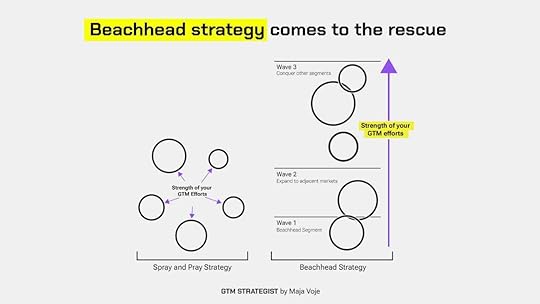 Shift from the ‘Spray and Pray Strategy’ to the ‘Beachhead Strategy’ to regain your GTM focus.
Shift from the ‘Spray and Pray Strategy’ to the ‘Beachhead Strategy’ to regain your GTM focus.In 2025, I’ve decided to live by the rule of radical focus.
I am serving my ICP in channels relevant to them.
Last year was more about experimentation to build one scalable and predictable GTM motion. This year is about developing a synergistic 2-3 GTM-motion approach to help me scale beyond product-market fit.
Every day is a test for me. To keep my focus, I must say “yes” to something and “no” to something else.
To gauge the importance of tasks, I have to keep asking myself:
Is this mission-critical 🎯?
 Quick reminder - these are 7 GTM Motions as I defined them in the GTM Strategist.
Quick reminder - these are 7 GTM Motions as I defined them in the GTM Strategist.Get good at things.
Do the critical mass of reps.
I am not trying to Marie Kondo my way into your head (Haiku is not my favorite poetry format anyway). Suppose you had 1-5 people on your marketing team who you sent chasing 30 different “personas” across 5 different GTM Motions - what do you think will happen?
Disappointment and a waste of resources.
So focus 🎯 - and one of the best ways to do this is to double down on your ICP - ideal customer profile (or ECP-early customer profile if you are pre-product-market fit).
Be mean about this.
You have my permission to say NO more often.
An opportunity could be outside your ICP bucket. You could be focused on your mission-critical goals, such as closing 500 customers this quarter.
In such a situation, to all those conference and roundtable invites, investment pitches (if you’re not raising right now), content collaboration ideas, and podcast invites (Except Lenny. If he invites, you must go), just say a big…

Right now, these are distractions, not new opportunities.
The only thing that will help you is to sell more, and often, in B2B, your touchpoints are on LinkedIn. So, you should be posting more, right?
 OLD WAY: Create content for everyone and hope to generate more leads
OLD WAY: Create content for everyone and hope to generate more leadsI sympathize with people who started inbound marketing in 2024/2025.
The reach is so much lower than it used to be.
Whenever you share something promotional, the algorithm slashes impressions.
Standing out is difficult in the flood of AI-generated content.
Using the old LinkedIn playbook, it’s still possible to cut through the noise and build a strong personal brand. But it consumes more resources than before.
It follows the AIDA model:
Attention (In some variations, Awareness)
Interest
Desire (In some variations, Decision)
Action
The old playbook works like this: You know only 3% of your market is ready to buy now, and you need to help more people on their buyer journey to reach that number. So, create more content for different funnel stages using blogs, case studies and LinkedIn posts.
My concern with the old playbook is this: “How do you deliver the content and to whom?”
Why would you spray a random piece of content on your top channel (say, LinkedIn profile) and annoy 10,000 people who are not even interested? All this just to find the 3%. It's quite wasteful.
Even if you’re sold on the “content creation game” as a long-term GTM strategy, you know it’s difficult to scale with moving targets. It fails to produce a predictable and seizable pipeline. It can take forever to build.
For instance, last week, someone who followed me in 2021 bought my services for the first time. I was happy, but I can’t afford to build a business with a 4-year sales cycle. I am not selling aeroplanes here. 🫢
So I told my clients starting inbound in 2025 this:
“Don’t lean heavily into LinkedIn content creation before having a social selling strategy. You need to sell - you don’t need to become an influencer.”
 NEW WAY: Social selling - Find hidden leads and start the sales conversation before getting inbound inquiries
NEW WAY: Social selling - Find hidden leads and start the sales conversation before getting inbound inquiriesMost of my market may not be ready to buy now, and I can produce some content to educate them. But what’s the point of meeting leads that don’t qualify?
There must be a better way to target the right people at the right time.
So here is a crazy idea: Let’s proactively talk to them.
Let’s track them using behavioral patterns and start the conversation.
Welcome to the universe of social selling!
Social selling is about using social media (LinkedIn) to connect with prospects, and build trust and nurture relationships with them.
It's not about hard selling—it's about sharing value, engaging authentically, and turning connections into loyal customers.
Cheesy, right? 🧀
Let’s get real:
Do not wait for leads to come to you.
As soon as an ICP-fit lead shows signs of buying intent, reach out to them.
Why should you care:
The typical reply rate of cold outreach to your ICP is <1%. You can bump this to double digits using social selling.
A word of caution: Don’t pitch your services in the first interaction. First, provide some value they care about.
❌ Thanks for accepting my invite. I see your SEO sucks, wanna have a 15-min meeting next week?
✅ Hi [First Name],
I enjoyed your session at [Event Name]! Your insights on [specific topic] gave me much to think about, particularly [specific example]. I’d love to schedule a quick call to hear more about your approach—would you be open to connecting next week?
Next, I will show you two data-backed ways to implement social selling (video demos inside):
1) Identify ICP-fit prospects on your website and start prospecting themFirst, find the hottest leads from your website.
These are already checking out your website but have not bought yet. You can quickly get this data using an analytics tool like Swan and act on it.
Swan is an AI-powered platform for converting anonymous website visitors into qualified leads and targeted LinkedIn outreach, as detailed in the text. It specializes in tools like website deanonymization, AI research, and AI personalization for B2B sales enablement.
I tried Swan, an AI-backed SDR, and its features stood out:
Automated qualification: I didn’t have to wrestle with complex filters and 50 drop-down windows — I could describe my ICP in human terms. Swan only reports on the leads that are relevant to you. You don’t have to research every visitor manually.
Effortless setup: Leads are sent straight to your Slack so you can address them in real time. I got lead details by the contact-level, not just the company-level.
Decision-making insights: Swan is useful for selling complex solutions. Swan's AI agent maps the decision-making teams in your prospects’ companies. You can know who the decision makers and target them with precision.
Personalized outreach: Swan also helps with LinkedIn automation at scale. I regularly reach out to my ICP-fit leads and get over 20 fresh DMs daily. Swan helped me enrich data and send personalized connection requests and DMs.
After I installed Swan on my GTM Strategist website, I was amazed to learn that decision-makers from Mastercard, Novartis, Panasonic, and Nestlé had visited it.
As the next step, I am developing new offers and products based on these insights to capture these warm leads.
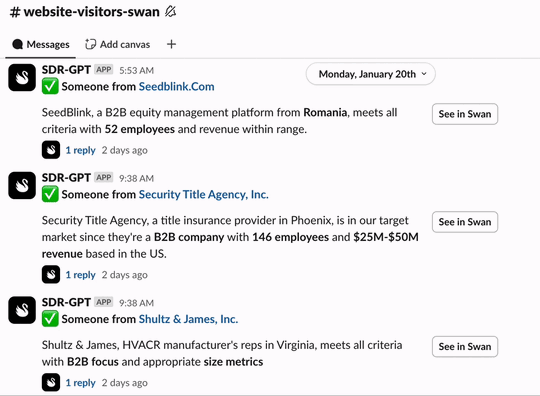 A screengrab of Swan’s AI SDR mentioning website visits by ICP-fit leads.
A screengrab of Swan’s AI SDR mentioning website visits by ICP-fit leads.Here are the reasons why I loved Swan:
It’s easy to set up and there’s an inflow of leads on Slack that I can start prospecting immediately.
Fascinatingly accurate definition of ICP that you can easily describe like a human
In-depth analysis of Decision Making Committee - if you are selling some more complex solution, multiple decision-makers will have to pitch in. With Swan, you can generate these insights and find the best leads.
Founder Amos is a sales and business development ninja. He offers a white-glove onboarding experience and ensures that your campaign is set up to deliver positive ROI quickly. Their pricing starts at $350 per month, which is less than what you pay for an hour of consultation with a semi-competent SDR who tells you what to do but does not get the work done for this price.
But what if your website barely gets traffic? And you’re investing so much on your LinkedIn only to see <10 ICP-fit leads a week in your inbox.
I found an exciting solution for this. 😇
2) Uncover hidden LinkedIn leads with WaalaxyPicture this:
You share a post at 11 am on LinkedIn.
It gets 10,000 impressions and 100 likes. But 0 leads.
This is a typical day in the content creation department.
But you need to educate your buyers before selling to them, right?
Well …
LinkedIn gurus are slowly transitioning from the “post more content” narrative to “start social selling.”
They used to tell you to say “Hi” to every new connection and then ask them, “What brought you to my profile?” The other norm is to send out 100 (not more) invites per week to your ICP.
You can automate this and build a system. Let’s see how you can do this with Waalaxy.
With a database of 500M highly qualified leads of +150,0000 users, 1 million campaigns, Waalaxy is on a mission to help you make LinkedIn your #1 acquisition channel by offering:
Streamline Outreach: Automate LinkedIn and email actions, track progress in real-time, and leverage AI writing assistance for personalized communication.
Seamless Data Management: Import, export, and manage leads in a CRM, with tools like Dropcontact for email discovery and CSV integration.
Customizable Workflows: Sync campaigns using webhooks like Zapier and set automatic lead imports based on criteria like profile views.
I love it and my clients love it, too. Waalaxy is available for free and does not require LinkedIn Sales Navigator.
It’s made with love in France 🇫🇷 by an awesome team.
Here is a quick demo of how I automate my connection requests, add connections from competitors and send social selling messages ONLY to my ICP-fit leads to book more meetings.
The pricing starts at $19/month per “social seller”. It’s easy to scale once you see more traction. They offer multiple team options to empower more “social sellers” and scale this motion once it works well. The fun part is that you can start using the forever-free version immediately. It lets you send 80 invitations per month and offers 25 email finder credits. What is not to like?
Remember, such automation tools must aid your engagement efforts on LinkedIn. They are not a replacement for personal interactions. We know LinkedIn can sometimes be harsh. 🧐
And I know what you’ll ask next - what to write to these people?
I compiled 15 social selling scripts - they are included in my ‘100-Step GTM Checklist’ that was tested with 7,500+ busines owners. You’ll also find guides, templates, and videos for pre- to post-launch scaling. Just a few days left for the January discount.

Until next time,
Maja
January 17, 2025
One Page, <20 min: All You Need to Craft Your Business Strategy
Dear GTM Strategist!
Since many of us are plotting new products and services for 2025 🤠, I felt this would be a great opportunity to discuss business strategy pragmatically.
In this post, you will learn how to apply the One-Page Endgame (OPE) canvas created by Wes Bush, author of The Product-Led Playbook, to your business. The process includes 3 steps:
Define ICP and the core assumptions around it
Select 3/15 moats to create an unfair competitive advantage
Create plans (yearly/monthly/quarterly) to achieve your endgame.
The OPE canvas was purposefully created for product-led companies. I have used it for a new product I am developing and tested it with three consultants in January - founders loved it.
I am a fan of OPE for these reasons:
It is ICP-centric, and most of us win by playing narrow before we can play big time.
OPE dives into the concept of moats 🏰- how you create a defensible competitive advantage for your business.
It has a tactical component as it invites you to craft yearly, quarterly and monthly plans and allocate resources. The OPE canvas helps you achieve the goals outlined in the business strategy.
You must complete the OPE exercise before hopping to GTM Power Hour framework, where you can list your GTM assumptions and make them actionable.
Tra-ra 🎺 - here is OPE 🗺️:
 The One-Page Endgame canvas as created by product-led growth expert Wes Bush.
The One-Page Endgame canvas as created by product-led growth expert Wes Bush.And magic 🪄
… it is now filled by entrepreneur Alex Turnbull for his new venture, Helply, an AI CX agent.
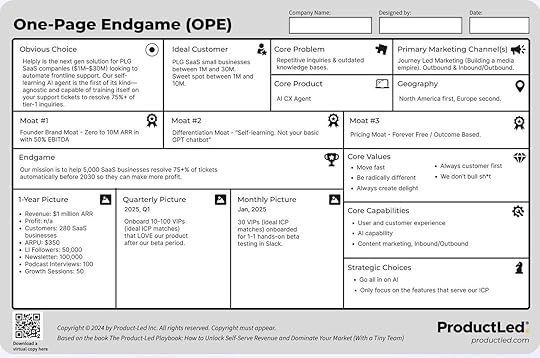 An example of a filled One-Page Endgame (OPE) sheet.
An example of a filled One-Page Endgame (OPE) sheet.Now, let’s learn how to apply it to your business.
Let’s do this!
Step 1: Set Up the Fundamentals (Your ICP on Steroids)If you have done your ICP and positioning work as suggested in the ‘Go-to-Market Strategist’ book, the top of the canvas should be easy to fill. It’ll be even easier if you’ve implemented the GTM Strategist Checklist.
 The top section of the One-Page Endgame canvas.
The top section of the One-Page Endgame canvas.Interestingly, the canvas starts with the ‘Obvious Choice’ field. You do not want to be a “good-to-have” solution for your ICP. You must become the go-to solution.
If you are new to the process and have done no GTM work yet, answer the questions in the best possible way. For the exercise, some guesswork will do.
Which markets can you dominate as an obvious choice?
Who is your ideal customer (someone who loves the product as it is today)?
What meaningful problem do you solve for them?
What is your core product (solution) for them?
What are your primary marketing channels to generate traffic and signups (go where the audience is)?
Which geography will you target (Wes suggests focusing on regions with the most number of ideal consumers)?
In the example above, Helply aspires to become the obvious choice for PLG SaaS companies looking to automate frontline support. It strives to solve the core problems of repetitive inquiries and outdated knowledge bases. It seeks to reach its ideal customer through journey-led marketing and inbound and outbound channels. Helply wants to prioritize North America over Europe.
Step 2: Select 3 Moats to Win The middle section of the One-Page Endgame canvas representing the selection of three moats.
The middle section of the One-Page Endgame canvas representing the selection of three moats.For me, this is the most essential part of the canvas.
The concept of moats 🏰 was popularized by investor Warren Buffett, who likened a company's competitive advantage to a moat surrounding a castle. The broader and deeper the moat, the harder it is for competitors to breach and capture your market share. He emphasized that the best businesses to invest in have a strong "moat" that ensures durable profitability over time.
To put it simply:
What do you have (or can build) to make your business the obvious choice for the target customer and that competitors can’t easily copy?
 The 15 moats for product-led growth as defined by Wes Bush, along with definitions and examples.
The 15 moats for product-led growth as defined by Wes Bush, along with definitions and examples.Wes Bush defines 15 moats that you should consider in the context of product-led growth:
1. Differentiation MoatDescription: Offering a product with unique features or solutions that stand out from competitors.
Example: Slack—differentiated by its user-friendly interface and integrations with countless tools to streamline team communication.
2. Cost Leadership MoatDescription: Delivering value at the lowest possible cost while maintaining product standards.
Example: Zoom—offers a cost-effective video conferencing solution with superior reliability, outpacing more expensive competitors.
3. User Experience MoatDescription: Providing an exceptional, intuitive experience that keeps users engaged and satisfied.
Example: Notion—gained traction owing to its clean, flexible workspace for organizing everything from notes to workflows.
4. Network Effects MoatDescription: Increasing product value as more users join and engage with the ecosystem. Usually applies to social media, team tools, collaboration tools and multiplayer games.
Example: LinkedIn—with over 950 million members as of 2024, it thrives on network effects by connecting professionals worldwide.
5. Operational Efficiency MoatDescription: Achieving superior efficiency in delivering value by optimizing internal processes and workflows. Operational efficiency often requires economies of scale, which is difficult to achieve for startups.
Example: Amazon Web Services (AWS)—AWS's operational efficiency supports over 30% of the global cloud market. It leverages massive economies of scale to deliver reliable cloud computing services at competitive prices, making it nearly impossible for smaller competitors to match its efficiency.
6. Branding and Reputation MoatDescription: Building trust and customer loyalty through a strong, recognizable brand and consistent reliability.
Example: Stripe—renowned for its developer-friendly payment solutions,it built a trusted brand by prioritizing easy integrations and reliability, becoming the backbone of online commerce for companies like Amazon and Shopify.
7. Distribution MoatDescription: Establishing access to unique or extensive distribution channels to reach more customers.
Example: Clay—As of 2024, it has grown to over 100,000 users across over 2,500 companies, including notable clients like Anthropic, Intercom, Notion, Vanta, and Verkada.
8. Speed and Innovation MoatDescription: Delivering rapid product updates and innovations to stay ahead of competitors.
Example: Figma—It frequently introduces real-time collaboration features and updates, enhancing user experience and staying ahead of design trends.
9. Pricing MoatDescription: Offering flexible and attractive pricing models that align with customer needs and budgets.
Example: Canva—offers a generous free plan and a Pro subscription at $12.99 per person/ month, while Adobe's Creative Cloud All Apps plan is priced at $54.99.
10. Free MoatDescription: Reducing barriers to entry by providing a free version of the product to attract and acquire users.
Example: ChatGPT—by offering free access to its AI-powered conversational platform,it attracted over 1 million users within just five days of its November 2022 launch. It had grown to over 300 million weekly active users by December 2024.
11. Switching Cost MoatDescription: Making it costlier or more challenging for users to switch to competing products due to contractual obligations, integration with other systems or data lock-ins.
Example: Tableau— locks in users with deep integrations, custom dashboards, and extensive training investments. Switching after three months could cost businesses thousands in re-training, data migration, and lost productivity.
12. Proprietary MoatDescription: Protecting your product through patents, unique technology, or exclusive data.
Example: NVIDIA—It leads the GPU market with over 15,000 patents worldwide. One notable patent example includes groundbreaking innovations in AI computing technology, solidifying its position as a tech powerhouse.
13. Engagement MoatDescription: Building stickiness by ensuring users frequently interact with and rely on the product. Works well for communities and companies with raving fans - high loyalty and WoM (word of mouth).
Example: GitHub— created a highly engaging platform by fostering collaboration through pull requests, issue tracking, and social coding, making it a go-to tool for developers worldwide with over 100 million users.
14. Expansion MoatDescription: Increasing customer lifetime value (LTV) by making it easier for customers to expand usage or add new features.
Example: HubSpot—started as a free CRM and sales tool and later expanded to the Marketing and Sales Hub, which sells multiplier services.
15. Founder Brand MoatDescription: Using the founder’s reputation and leadership to create trust and visibility for the product.
Example: Superhuman—leveraged Rahul Vohra’s brand and insights to attract early adopters to the email platform. An extreme case is Elon Musk, who says his companies don’t need marketing.
Each of these moats helps a product-led business build and maintain a durable competitive advantage, driving long-term growth and resilience.
The fun part - you can only choose 3. Alex from Helply selected founder-brand, differentiation and pricing moats.
What will you choose? 🤠
Step 3: Plan Your Endgame and Execute ItWes suggests starting this by stating your endgame, which is super interesting.
Some examples:
Create $1 million ARR by year-end
Get $200 validation and exit the company
Win 1,000,000 users in 3 years
Have 100 people (or five) work at your company in the next year
Just be honest here … Nobody will judge you.
The next step is to define what progressing towards the endgame will look like after a year, every quarter, and every month.
 The section of One-Page Endgame canvas representing periodic goals and resources needed to achieve them.
The section of One-Page Endgame canvas representing periodic goals and resources needed to achieve them.The last part of the OPE canvas asks:
What would it take to execute your plan?
Wes breaks this down to core values, capacities, strategic choices, and allocation.
A word of caution: While it is fun to add things to your to-do list, you are bound by resources, time, people, and money. Decide what you’ll drop and figure out how you’ll increase capacity.
You can’t take on more without saying “no” to other things.
Focus = saying no.
🥁🥁🥁
And congrats - you have created a pretty canvas!
You can paste it to your office wall or brag about its use on LinkedIn.
Just kidding - what you created is a powerful alignment tool for your team.
But this is not a set-it-and-forget-it exercise.
What makes the difference is how you act on it. - So here is my challenge to you:
✍️ What can you do TODAY to get one step closer to your endgame?
You know the answer, so start working on it.
Return to this canvas periodically to update it with newer insights and traction numbers. I review such materials every week before planning for the next week. Even if you don’t wholly reach your endgame, you’re better than those stuck in analysis paralysis.
Bring out your own personal innovation and speed moats.
Loved reading this post?
Which part of the OPE canvas is the most important for a business? Let’s discuss this in the comments.
Are you intrigued by Wes Bush’s OPE framework? Check out his new book - ‘The Product-Led Playbook’ on Amazon. I binged it in 2 days. Proof 🤠

These are the books I am reading in January 🗓️
And hell yes - I am re-reading my book ‘Go-to Market Strategist', which explores how to play on your strengths and build a competitive edge. Reach product-market fit quickly. 40% discounted in January on Amazon - get your copy.
Start working towards your endgame today with 100+ checkpoints I’ve compiled covering all aspects of go-to-market. I’ve tested them successfully on 750+ launches (emails, launch plans, posts, landing pages). Get the GTM Checklist today.
And I am in my maker mode, so ❌ more consultations in January - sorry.
Gotta focus 🎯 on bringing my One Page Endgame to life 🤘
January 10, 2025
My 5-Step LinkedIn Viral Post Framework
Dear GTM Strategist!
After tremendous engagement, I have gotten privately to my previous post - “My 7-Day Business Idea Validation Framework: Actual case study for an AI chatbot: 21 hours of work, $20 budget” - my assumption is that you are up for more tactical posts in 2025.
So, I wanted to present you my 5-step framework for building my LinkedIn viral posts, which are a HUGE part of my launches. After the holidays, the traction on LinkedIn was a bit slower and I wanted to warm up the scene a little 🔥 so we are ready to start 2025 on a strong note.
🚨 Note that this tactic is not innocent:
LinkedIn says they will suppress the reach of such posts soon
Lots of people complain that their feed is turning into viral posts dumpster
I was temporarily restricted from LinkedIn once for 23 hours because I sent out too many messages when I had my last viral post
But - I am back doing it - more cautiously, though, because:
It still works like a charm, and I will do it as long as it works.
If you are curious how to build viral sensations on LinkedIn, I have a treat for you:
 For now, this process works super well if you do it right.
For now, this process works super well if you do it right.Before we dive in - let me stress that I use this tactic conservatively because it can attract a lot of shit-leads to your email lists and adds up a considerate workload to admin if you want to execute it sustainably (actually keeping your promise). Use it with discretion (while it still works).
Step 1: Create a Strategic Asset with Viral PotentialNot every brain dump deserves to be a viral post. Sure, you can go viral with screenshots of ads or landing pages, reading lists, and 15-year olf pitch decks from the internet - it will get you vanity metrics in. But to have a good sales result, you have to think strategically - what will attract your ICP and how will you create a first impression so good they will assume you are crazy for giving this out for free?
How I do it:
Rule #1: The asset MUST be relevant to your Ideal Customer Profile (ICP).
Use assets built on 50+ hours of analysis and aligned with your business.
The asset should have potential upsell opportunities.
Shortcut: Use the by-products of your work to create assets that you’ve made, tried, and tested.
Example from a campaign this week:
I was exploring best practices from expert content creators (not copywriters, not storytellers, not full-time content creators, not fortune cookie inspo quote makers) - from people that actually work outside LinkedIn and can spare up to 8 hours a week on content creation. My team and I invested 56 hours into this analysis to gain insights into how to write more applicable content - not just one mental model on top of another. I stand by this board and I use it for my content strategy. This is why it deserved to be a viral asset.
 Here is my LinkedIn moodboard (non-gated link): https://miro.com/app/board/uXjVL3URF94=/ Step 2: Engineer the Lead Nurturing/Upsell Dynamic
Here is my LinkedIn moodboard (non-gated link): https://miro.com/app/board/uXjVL3URF94=/ Step 2: Engineer the Lead Nurturing/Upsell DynamicIntentionality is the key - to go “viral” is a vague goal. Roll the hamster wheel in the strategic thinking part of your brain and answer your self a question - why are you doing this? If you just wanna boost your LinkedIn traction, fine - you do you, whatever you think will “go viral” memes and cat pics to the rescue. But if you would like to develop a lead nurturing campaign and actually gain relevant leads and sell something, you need to be more intentional.
How I do it:
Define the goal of the campaign and set clear objectives.
Decide whether nurturing will be done through LinkedIn or email (gated or non-gated).
Identify a natural upsell: How can your ICP get more of the same or similar value?
Be careful with automations – aggressive use may get you restricted on LinkedIn.
Example: My email automation system balances value delivery with lead nurturing.
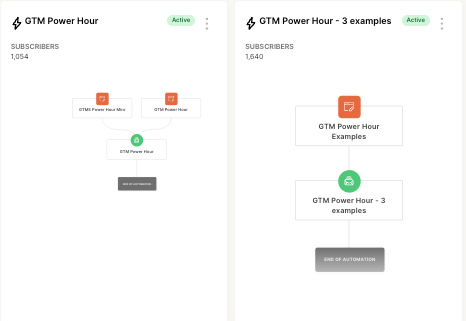 Example of a simple automation in Kit
Example of a simple automation in KitExample from a campaign this week:
This lead magnet was outside my core ICP for consulting, so I did not develop a service offer for this campaign. If I used it for consulting, I would first validate an ICP-fit and only talk to relevant prospects. For broader campaigns, I lead with digital products - if the audience enjoyed this asset and got a lot of value out of it, they can get 100+ more of such goodies by getting my GTM Checklist which is applicable for more professionals.
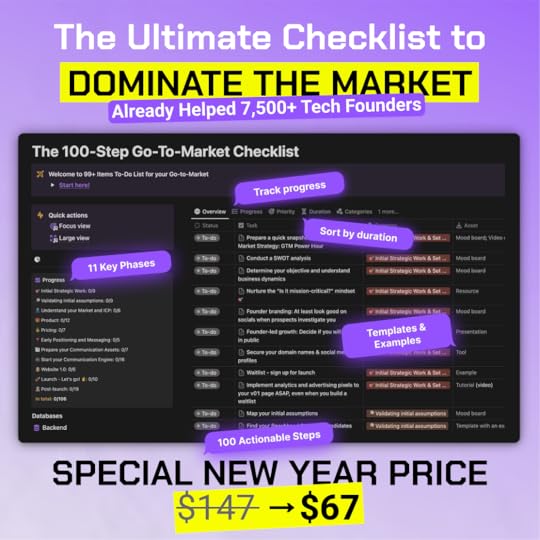 My GTM Checklist is available for a discounted price of $67 for a limited time - get it at https://gtmstrategist.com/gtm-checklist/Step 3: Launch the Post on LinkedIn
My GTM Checklist is available for a discounted price of $67 for a limited time - get it at https://gtmstrategist.com/gtm-checklist/Step 3: Launch the Post on LinkedInThis is where you make it or break it. If your post is off, if you do not create the critical mass of early engagement, or if the audience starts to complain about the quality of lead magnet - game over. All this effort went in vain.
I started doing viral posts in June 2024 by simply copying the structure of another viral post and guess what - if you just save a couple of successful viral posts that you like, feed them to the AI model of your choice and tweak it as only you can - this is not that complicated. But you have to be there and fight for early engagement.
How I do it:
Use best practices for viral posts—study successful creators and feed examples to your go-to AI model.
Create a video preview of the asset that communicates the Unique Value Proposition (UVP) and Unique Selling Point (USP).
Highlight what’s in it for the audience and why your asset is better/different.
Timing: Sunday afternoon Go-To-Market (GTM) strategy works best for me.
Engage intensely for the first 2–3 hours after posting—this is critical for traction.
Example from a campaign this week:
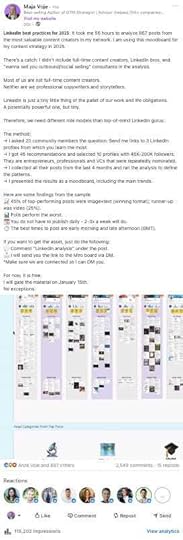 Post and traction in the first 20 hoursStep 4: Observe Traction and Adjust
Post and traction in the first 20 hoursStep 4: Observe Traction and AdjustThis step is very simple. You can face two opposite problems:
The post does not pick off - in this case - DM comes to the rescue - just ask some colleagues or, even better, ICP-fit connections to engage, comment, and like it.
If the post really picks off - you will have a strong admin issue.
 Stats 20 hours after posting. Now it has already more than 150k impressions.
Stats 20 hours after posting. Now it has already more than 150k impressions.Example from a campaign this week:
I have never had a problem with engagement for a viral lead magnet, but processes and making sure the assets are delivered is a huge pain. You should not trigger safety mechanism for spamming Linked and even though you would like to send everyone the asset immediately - rather play safe then sorry.
Step 5: Ensure DeliveryI am known to have very good lead magnets and I tend to keep my promise that your effort of engaging will not go to vain. If I possibly can, I like to chat with you guys, too. Sometimes people test me if I am a bot - it is very fun :D
While I am doing these campaigns, I learned a lot- with some of you - that have read the book and followed my Substack. It is actually the first 1:1 touchpoint that I have, so I will try hard to answer all the meaningful messages and comments myself.
But too much is too much, it would be a huge vaste of my time if I would be sitting down for 3 days copy-pasting the same message - for that we have technology …
 Some feedback I got to my latest lead magnet
Some feedback I got to my latest lead magnetHow I do it
Avoid LinkedIn restrictions by sending fewer than 100 DMs/day (conservatively).
My approach: I’ve pushed up to 300/day; I tried 500/day but faced consequences.
Work with virtual assistants (VAs) or custom-built automation/copilots to avoid triggering spam alerts.
If working with VAs, use VPNs connected to your primary location to stay compliant.
Mission-critical: Always deliver on your promises to avoid damaging goodwill.
Example from my campaign this week:
Over 30 hours went into distribution and engagement efforts and we are still not finished. We will do it, but slowly and steadily so I do not get temporarily restricted again. 🤠 I want to talk with you on LinkedIn every day.
Because I am limited to sending 150 messages a day, I couldn’t send the asset (LinkedIn moodboard) to everyone yet. If you didn’t get it yet, here it is: https://miro.com/app/board/uXjVL3URF94=/
Scorecard of my latest campaignEffort: $1,000 opportunity cost and 30+ hours of hard work.
ROI: Achieve 5–12x returns based on my campaigns.
Make sure to deliver on your promises—your reputation depends on it.
Do this occasionally (1–2 times/month) to sustain results.
How did you enjoy this post?
Please reply to this email, send me a DM on LinkedIn or comment if you prefer more applied content or should focus more on uncovering interesting theoretical concepts and mental models.
Use this one with care and a lot of respect for your audience while it still works.
And make sure you do not miss out my January deal that will help you start 2025 on a strong note.
Sincerely,
Maja
January 3, 2025
My 7-Day Business Idea Validation Framework
Dear GTM Strategist!
I hope that 2025 started great for you. For the new year, I made one BIG commitment: Launch my very first AI product.
Initially, I thought Q1 would be dedicated to validating the use case. You know - doing 30 interviews, prototyping, running a use case workshop with a field expert, investing min. $30K into the product … until I asked myself: is that necessary?
Why should I impose traditional methodologies and fictional timelines on my validation process?
Since I found very few reasons to justify the initial thought, I turned back to one of my best friends - rapid experimentation - and went on a mission:
Can I build a prototype, get at least 100 relevant users to test it, and find good insights to narrow down my value proposition to a single use case in less than a week?
I present my 7-Day Business Idea Validation Framework, which I used for three hours a day for seven days before Christmas to validate one of my big strategic bets for 2025.
My 7-Day Idea Validation Framework The 7-Day Idea Validation Framework was tested on affordable AI SaaS products (agents) and digital products. It does not apply directly to e-commerce and enterprise sales.
The 7-Day Idea Validation Framework was tested on affordable AI SaaS products (agents) and digital products. It does not apply directly to e-commerce and enterprise sales.Now, let’s dive right in!
DAY 1: Lead with your vision and market insightsEvery excellent product journey starts with the inception of a big vision. What do you see/know that others do not? If you think about entrepreneurship as creative problem-solving, you must start with understanding the environment: what is good and what needs improvement.
Framework I used: SWOT analysis
If you are as unimpressed with spending a lot of time doing macro market analysis as I am, a simple SWOT analysis will help you grasp the main opportunities and threats and realistically value them against your strengths and weaknesses.
 SWOT analysis framework is over 60+ years old and it still works like a charm
SWOT analysis framework is over 60+ years old and it still works like a charmBetter yet, drive the inspiration from your business practice. What is the problem that you have solved before? How to tweak a solution that would help many more people?
In my 15 years of experience, I have built thousands of GTM strategies as a consultant. I know the process inside out, and I have spent two years creating knowledge assets (digital products, book, Substack posts, workshops, LinkedIn posts) to help people navigate the process of building a GTM strategy. However, my time and bandwidth are limited; and reading or watching the materials is not always the most effective way for my audience to get the specific answers they need for their business.
My vision is to bring you actionable answers in seconds instead of encouraging you to follow me on LinkedIn or read 350 pages of a book to find something suitable for you. This was my big inception in 2024 - and AI has opened new ways for me to deliver you value more effectively: faster, better, more tailored, cheaper. This is the frontier I have to conquer.
DAY 2: Define minimum viable segment - Early Customer Profile (ECP)After the initial product inception, I have to find the Early Customer Profile for my new launch. Who can benefit most from the value delivery mechanism I have in mind? When selecting this profile - also called the Beachhead Segment - I have four characteristics in mind:
A burning pain point - this problem needs to be solved now.
Sufficient willingness to pay - AI model costs money to run. I need to think about the business model as soon as possible. Who has the resources and willingness to pay becomes a mission-critical question when you are bootstrapping.
My proximity to the segment - based on my previous work and network, I need to select an ECP that I can realistically win a significant proportion of the market in the next 3 months that I can invest in this project. I want to play where I can win, also considering the competitive solutions in the space.
This segment needs to create relevant case studies, testimonials and sufficient amount of reviews. It will be a proof that my product works so that I can continue to move upmarket later and use social proof in my marketing and sales.
Frameworks I used: Market-Problem Map and problem space visualization.
To bring all the information together, I used the Market-Problem Map framework developed by Simon Belak, data scientist and CTO (prev. Zebra BI, Metabase), and visualized my ECP’s problem space with a nice visual that guides my decision-making, nurtures empathy and inspires me to do my very best to help this person.
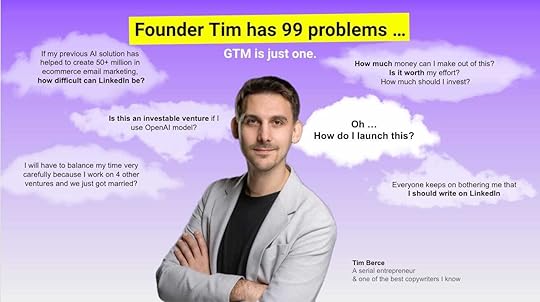 Example of the problem space visualization for selected ECP - “founder Tim”DAY 3: Create value proposition
Example of the problem space visualization for selected ECP - “founder Tim”DAY 3: Create value propositionI could potentially solve many of my ECP's problems, but I know from my business practice that the best niche AI products serve a narrow audience and use case. I had to narrow down my value proposition to my target audience. In the broadest aspect, I am “helping Tim to do marketing/launch/sales aka GTM” (his words, not mine) and he needs assets, not more theory, to get things done.
That led me to believe that a perfect use case I will select is:
Highly tactical - do something that has immediate added value for ECP.
Low time to value - he can grasp it in seconds and apply it in hours (better minutes). You do not send people to commit to some long-term distant-goal tasks if you want the probability of the wow effect to emerge sooner.
I also generated intelligence from my business practice what were the most frequent service requests from the founders I worked with for implementation - what would they outsource.
Framework I used: Value Proposition Template by Paweł Huryn and Aatir Abdul Rauf
To get more tactical, I used Value Proposition Template to refine my thinking about the problem space I previously tackled to jobs to be done by my selected ECP. I believe great products are transformational in terms of bridging the gap between the current state, which is imperfect and painful for ECP, to a desired future state where the customer is better off.
 This is an example from Canva that we all know. Grab a blank copy of the template here (non-gated)
This is an example from Canva that we all know. Grab a blank copy of the template here (non-gated)Here, I inevitably bumped into a positioning problem (next step): how else can Tim solve his marketing/sale/launch problems? What are the competitive alternatives I have to fight against?
DAY 4: Minimum viable positioningMy ECP (let’s continue to call him Tim) would naturally lean towards DIY-ing this based on some templates. The problem is that most templates were not tested on businesses of his size and industry. Tim is also a highly time-sensitive person since his time has a serious opportunity cost. He could go ahead and hire a freelancer or smaller agencies. The challenge is that he will find it incredibly hard to find someone with a proven track record in his niche at the budget he has in mind, plus he does not really like meetings and managing people/handling onboarding.
As long as I can make something that is comparable with the quality of non-field-expert, lower-fee service providers within a fraction of the time and effort that Tim has to put into this - I could have a winning product.
Framework I used: Competitive alternatives scoring by Andrej Peršolja
 How to use it: List the competitive alternatives and criteria by which your ECP evaluates the solutions. Rate them 1-5 in terms of how well a competitive alternative services these criteria.
How to use it: List the competitive alternatives and criteria by which your ECP evaluates the solutions. Rate them 1-5 in terms of how well a competitive alternative services these criteria.Based on identifying my differentiations, I developed my UVP (Unique Value Proposition, your promise to the customer):
Get actionable go-to-market assets in seconds
And these were my Unique Selling Propositions (USPs, “why this solution”):
Methodology tested on 8000+ companies
Trained on 1 million characters proprietary knowledge base including a best-selling book GTM Strategist
It is for free - the max you can lose is 3 minutes of your time. Is it worth a shot?
But what exactly to focus on - landing pages, ads, emails, presentations …? I need to do one thing really well before potentially exploring other use cases. Focus is the name of the game when we are creating AI agents in small teams. ✌️
Do not guess - test!
DAY 5: Select the validation methodPeople do > People say.
I needed rapid validation with high confidence. Here is my reasoning for why I feel much more confident about this way of validating the products than following the traditional blueprint:
For this product, I am “eating my own dog food” and innovating for the existing audience, which I know inside out - I spend 30 hours a week with them working on specific challenges.
It is easier than ever to deploy prototypes, and no-code tools and agent builders have made it more accessible than ever to build prototypes.
There is a knowledge asymmetry between makers and users of innovative solutions. You have to teach and lead by example, or even better: case studies with proven results. Give your audience ideas on how you can elevate their business.
By no means am I underestimating my audience. Still, the fact is that we are learning by doing together in this stage of technology, and if I solely relied on my target audience's imagination of what the product could be. As a maker, I have to bring the element of a product vision and unique methodology to solve this problem to the equation.
We are all limited by time and resources. I want to make it in a way that will radically decrease time to value because speed is of the essence in innovation. The sooner I can get real people to use it, the better.
Framework I used: Adjusted Validation Methods framework by dr. Else van der Berg
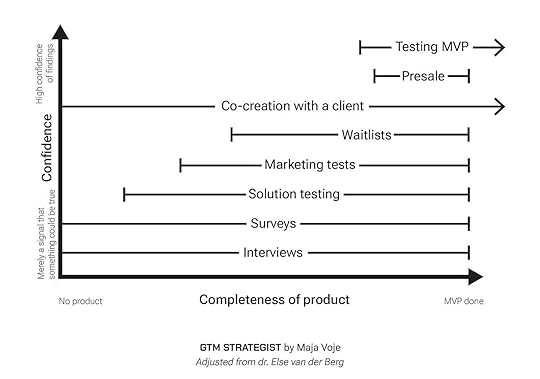
I decided to do a soft launch on LinkedIn because the majority of the ECP audience is there. I didn’t do an email blast (which could produce way better results) or launch with influencers like I do for the main launches because there was no need to get thousands of users in this iteration of the product just yet. It would not be fair to hype it more because it is a test build, not a polished product that I can absolutely stand by and guarantee that it will work amazingly well for you. As such, it does not deserve a full blast just yet.
If you don’t have the audience to launch to, some of my teams used social media groups relevant for their ECP, cold outreach (emails), and ads to achieve the same and, in some cases, even better traction. If you can build it - you can test it. No excuses.
DAY 6: Idea validation experiment designThe validation methods that were appropriate to me were marketing tests and product tests. We built a beta version of the business idea (not the final product) based on my existing assets with a no-code tool, tested it, improved the core prompts, and launched it. Huge thanks to Ihor Dervishov, the maker of Elsa ICP identifier, for helping us put this build up in less than 3 hours. The only cost we had was a $20 Chatbase subscription.

Simple as this. You can take the chatbot for a spin here: https://www.chatbase.co/chatbot-iframe/1CIb6e-YmhvkXSRzgNrGJ
More problematic was to decide on what sample size of users I needed.
I was in constant touch with other AI product builders and tech experts from my network.
The thing that worried me the most was whether the sample size would be sufficient to analyze. The feedback radically varied. One said that I could get the core inception with 30 testers that have conversations with at least three refinement messages exchange, and most agreed that 100 serious users would do the trick. I was aiming for 300 users because it is a nice number and I prefer to play safe here.
DAY 7: Launch & analysisI launched and invited my audience on LinkedIn to take the test build for a spin. Here is the message and results of the campaign:
 https://www.linkedin.com/posts/majavoje_i-put-all-my-assets-more-than-1-million-activity-7275076687212478464-mY-b
https://www.linkedin.com/posts/majavoje_i-put-all-my-assets-more-than-1-million-activity-7275076687212478464-mY-bThen I sent out some more DMs on LinkedIn and WhatsApp to ensure that we hit the number. If I still needed more testers, I would post in a couple of social media groups, ask some of my colleagues to share it in their network, or ask testers who else should take it for a spin.
300 is not a big number - everyone can figure out how to get there. If it is mission critical, I would even go to the main city square and hand over the flyers - I already did that once. Where there is a will, there is a way.
Over a week of the GTM Strategist chatbot being live, we had 418 chats, resulting in 3724 messages. Most people liked the answers. The analytics was not perfect because we did not do user identification yet - at this stage, we are simply validating the use case. We will test for ECP refinement in the next iteration.

In this build, I was searching for two things:
Where did the bot worked surprisingly well
What will be the most frequent use cases
But what really amazed me:
When the bot was offline (I was on holiday and could not offer support), 15 people demanded it to be back on, which shows a good sign for potential retention.
Two people said they would pay for it - well, you are super kind, but let’s wait for the real thing. This was a “let’s test if you want this idea” version.
And voilà! This is it.
Was it difficult? No.
Was it scary? Yes. The good old fear of rejection.
Was it useful? Hell, yes! I am already plotting the next build.
If you want to know anything else - feel free to send me an email or ask questions in the comments. I am glad to help.
Thanks so much for participating in this research.
I hope you are getting as much value from this as I am, otherwise, write back to me and explain what is wrong, and I will do my best to fix it.
2025 will be fun.
You know it - I know it ✌️
Now let’s go and build some cool things.
Are you ready to dive deeper and work on your Go-To-Market strategy and execution?Discover my solutions that support your journey from launching to scaling:
🛰️ Explorer: Understand Go-To-Market and develop a winning GTM plan.
Get best selling GTM Strategist book + 20 frameworks (workshops) + online course ($47). Tested by 7500+ companies
🚀 Doer: Leverage the 100-step GTM Checklist tested on 750+ launches with templates (emails, launch plans, posts, landing pages), which will guide you from getting ready to launch to an impactful launch and scaling stage.
Get the Checklist ($97)
💫 Leader: Guide your team to successfully choose ICP (target market), pricing, positioning & selection of best GTM Motion (channels, tactics). GTM Bootcamp includes 5 hours of applicable videos and a personal Miro board.
Get the Bootcamp ($347)
December 27, 2024
2024 in Review at GTM Strategist
Dear GTM Strategist!
Before I write anything else - let me give you a huge shout-out.
I am endlessly grateful that you are on this journey with me.
You are my why - your interest, support, and friendship are mission-critical for me to move forward. I started publishing this weekly Substack one year ago, and here are some learnings, highlights and plans I would like to share with you before we wish each other a happy 2025.
In this Substack, we will briefly dive into:
Top 3 Substack articles that raised the most dust in 2024 🌬️
Top 3 collaborations with other authors in 2024
Top 3 performing viral assets from LinkedIn that you can revisit
Some 2025 plans 🔮- others are still stealth …
So, let’s dive right in!
3 Top Substack Articles in 2024: ECP, GTM Milestones and GTM ActionsIn 2024, I published 52 posts for the GTM Strategist Substack. Some topics landed, others not so much. We are learning by doing here. Here are the three Substack posts that you appeared to like the most. If you joined this newsletter recently, make sure to check them out!
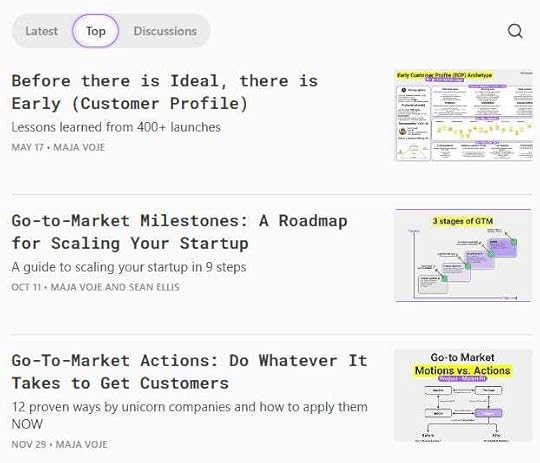 These were the 3 best-performing articles in engagement - I get the clue … you want more GTM
These were the 3 best-performing articles in engagement - I get the clue … you want more GTMHere is why I invite you to revisit these topics:
🏆Absolute winner: Early Customer Profile (ECP) teaches you that, more often than not, you have to build evidence (case studies, traction, references) before you can win Ideal Customer Profile (ICP). For that, you need early customers. Here is how to find them:
https://knowledge.gtmstrategist.com/p/before-there-is-ideal-there-is-early
3 Go-to-Market Stages was my collaboration with the godfather of growth hacking, Sean Ellis. We explored what is mission-critical to do to defend product-market fit and get your company ready for scaling. Learn more here: https://knowledge.gtmstrategist.com/p/go-to-market-milestones-a-roadmap-for-startup-scaling
Go-to-market Actions: Go-to-Market motions are predictable and scalable ways how to attract customers to your product. But before they are super normalized and efficient, you have to do whatever is mission critical to get customers. I call that GTM Actions. Here is how successful startups such as Rows.com Tally, Userpilot, Command AI (recently acquired by Amplitude), and Tella got their first customer (real examples):
https://knowledge.gtmstrategist.com/p/go-to-market-actions-to-get-customers
What do you want more of in 2025? Hit reply to this email or engage in comments to co-create my 2025 content strategy. My question is simple: How can I best support your go-to-market journey? Share some ideas so I can serve you better in the future.
3 most popular collabs: Kyle Poyar, Aaakash Gupta, Paweł HurynIn 2024, I did dozens of podcasts and Substack placements with other mega creators. Never in my wildest dreams have I imagined that one of those articles would be the most popular on the Substack, which I read and learn from daily.
 This is such a thing from my bucket list - I really wanted to work with Kyle … Luckily, his community liked our collab 🙏
This is such a thing from my bucket list - I really wanted to work with Kyle … Luckily, his community liked our collab 🙏Kyle Poyar (Growth Unhinged) - How to build Go-to-Market strategy from the scratch - all the core concepts and an actionable framework for building a GTM Strategy (“Go-to-Market Power Hour”) packed in a single article:
 Kyle Poyar’s Growth UnhingedHow to build your GTM strategy from scratch👋 Hi, it’s Kyle Poyar and welcome to Growth Unhinged, my weekly newsletter exploring the hidden playbooks behind the fastest-growing startups…Read more2 months ago · 241 likes · 19 comments · Maja Voje
Kyle Poyar’s Growth UnhingedHow to build your GTM strategy from scratch👋 Hi, it’s Kyle Poyar and welcome to Growth Unhinged, my weekly newsletter exploring the hidden playbooks behind the fastest-growing startups…Read more2 months ago · 241 likes · 19 comments · Maja VojeAakash Gupta (Product Growth) - Aakash and I dived into different Go-to-Market Motions. We shared examples and practical tutorials on how to get users and customers for your product. Learn more here:
 Product GrowthTactical Go-to-Market 101: How to Go From 0 to 1For product people, go-to-market can seem like a bit of a mystery…Read more7 months ago · 132 likes · 5 comments · Aakash Gupta and Maja Voje
Product GrowthTactical Go-to-Market 101: How to Go From 0 to 1For product people, go-to-market can seem like a bit of a mystery…Read more7 months ago · 132 likes · 5 comments · Aakash Gupta and Maja VojePaweł Huryn (The Product Compass) - For my book, I learned more from product managers than any other discipline. So it was my time to give back. Paweł allowed me to highlight 5 principles that every PM should know:
 The Product Compass5 GTM Principles You Should Know as a PMHey, Paweł here. Welcome to the free archived edition of The Product Compass…Read more5 months ago · 84 likes · 9 comments · Maja Voje and Paweł Huryn
The Product Compass5 GTM Principles You Should Know as a PMHey, Paweł here. Welcome to the free archived edition of The Product Compass…Read more5 months ago · 84 likes · 9 comments · Maja Voje and Paweł HurynMoreover, we became great friends in the process. We interact on a weekly basis and he will join us as a guest here in 2025.
I would like to sincerely thank ALL the authors that I collaborated with in 2024. Your kindness in bringing my take on the go-to-market discipline to your audience plays a vital role in achieving my mission to help 10,000 companies a year cross the chasm. Huge thanks for your work and insights. I admire and respect all of you so much. You are my inspiration.
3 TOP LinkedIn viral posts: 3 examples of GTM, Go-to-Market Power Hour and sales decksIf you open your LinkedIn now, it will be packed with “comment X to get Y” viral posts. Some creators even fail to send assets or send some promo materials, ChatGPT generated BS - well, definitely not me. I share my best, not worst, work. In every asset that we share, my team and I put in at least 30 hours of very hard work, and we always share hands-on examples and insights.
 Here is a collection of my most engaged posts on LinkedIn in 2025 - number one made me temporarily restricted from LinkedIn for 26 hours because I sent out too many messages 🙈
Here is a collection of my most engaged posts on LinkedIn in 2025 - number one made me temporarily restricted from LinkedIn for 26 hours because I sent out too many messages 🙈These were my most popular assets that went viral through LinkedIn posts 🧲 (non-gated):
GTM Power Hour with 3 Examples: Go-to market plan is different if you are pre-product market fit than if you are scaling. I presented three examples of GTM plans made with my GTM Power Hour ⚡ template (pre-product market fit, product-market fit, and scaling) here: https://miro.com/app/board/uXjVLHOb_YU=/
GTM Power Hour ⚡ - Can you list all the key go-to-market assumptions and make a plan on how to validate them in less than 60 minutes? I know you can. Why? Because I have done it 300 times on a whiteboard before I published this template + video tutorial where you can watch me doing it here: https://miro.com/app/board/uXjVK-mFlnQ=/
Sales Decks - collection and analysis of 5 sales decks from real companies based on a template from April Dunford’s Sales Pitch best-selling book: https://miro.com/app/board/uXjVLLgG-Pw=/
The reason why I started to do viral posts in June 2024 is to support our mission to help 10,000 companies cross the chasm and introduce our take on go-to-market strategy to more audiences. It is a brilliant way to grow your network, but the materials you share have to be outstanding because the first impression MORE than matters.
Rumor has it that LinkedIn will soon start to penalize this type of posts, so I do not think this tactic will be sustainable in 2025, but we had a good ride 🤠. But you know how it is: when one door closes, the other opens. We will find something that will help us to stand out in 2025, no worries. It is mission-critical and I will tackle it because we are in it to win it ✌️.
Plans for 2025 for my 3 business unitsLast but not least, let me whisper some of the strategic directions I have confirmed with my team, partners and trusted advisors for 2025. I will share one for each business unit: Product, Media and Consulting
GTM Strategist Products: Everything we have so far will become AI-supported. The first attempt at this was my MVI (Minimum Viable Idea) of the chatbot. In Q1, I will update all the existing materials with new content.
GTM Strategist Media: I will double down on media. ATM, I am hiring a new editor and making final arrangements for sponsorships in Q1. In 2024, 17 partners supported my content. The biggest supporters were Clay, Amplitude, HubSpot, and MeetRecord. I am hugely grateful for your support. Your support helps keep this Substack free for everyone. It enables me to spend more time on content and hire more people. If you would like to sponsor my content stream (Substack + LinkedIn Newsletter 15K) and/or LinkedIn post (52K), you are welcome to reach out and let’s see if we can make it happen.
GTM Strategist Consulting: I successfully validated Go-to-Market corporate and VC workshops as a top-performing consulting product in 2024. I will spend more time developing new content and frameworks for this pillar because a corporation cannot just move fast and break things. I am one email away if you are interested in this type of work. My travel plans for H1 are not 100% fixed yet, but I have great experience with online workshops in Miro.
YOUYou make all this possible 🙏
Without you, my mission of bringing 10,000 companies a year across the chasm would be a crazy idea and a daydream. You made it a global movement.
Quetta (1030) thanks to YOU.
I wish you a joyful and triumphant transition to 2025!
Let’s continue to think together next year. 🏆
Maja
Are you ready to dive deeper and work on your Go-To-Market strategy and execution?Discover my solutions that support your journey from launching to scaling:
🛰️ Explorer: Understand Go-To-Market and develop a winning GTM plan.
Get best selling GTM Strategist book + 20 frameworks (workshops) + online course ($47). Tested by 7500+ companies
🚀 Doer: Leverage the 100-step GTM Checklist tested on 750+ launches with templates (emails, launch plans, posts, landing pages), which will guide you from getting ready to launch to an impactful launch and scaling stage.
Get the Checklist ($97)
💫 Leader: Guide your team to successfully choose ICP (target market), pricing, positioning & selection of best GTM Motion (channels, tactics). GTM Bootcamp includes 5 hours of applicable videos and a personal Miro board.
Get the Bootcamp ($347)
December 20, 2024
Experiment More, Grow More: 3 Steps You Must Know

This post is supported by Amplitude, a leading analytics platform for product and marketing teams. They shared 5 case studies with actionable examples of how companies have prepared fruitful organizational, cultural, technological, and analytical systems to support rapid experimentation and growth. Get Amplitude’s Guide to Growth here.
Dear GTM Strategist!
In this Substack, you will learn:
The secret behind exponential growth rates
Why most organizations fail to launch even 3 experiments a week
Why you must create a “single source of truth”
Why silos are the hurdles you should tackle immediately
How to start running your experimentation process
Let’s G(r)o(w)! 🚀
(and prepare a fruitful terrain to scale in 2025 🧑🌾)
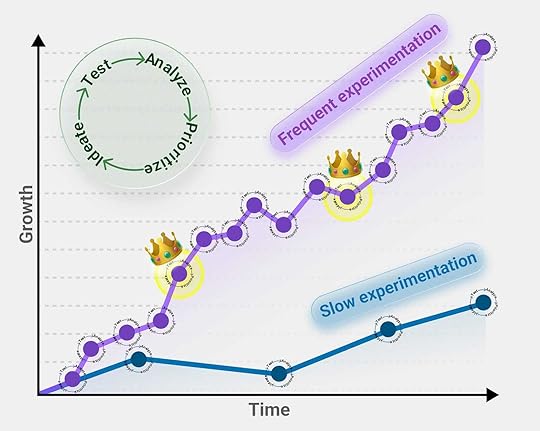 If 1-2/10 experiments are going to be successful, you need to experiment fast(er) to winThe faster you experiment - the quicker you grow
If 1-2/10 experiments are going to be successful, you need to experiment fast(er) to winThe faster you experiment - the quicker you growJeff Bezos famously said in one of his shareholder letters:
“Our success at Amazon is a function of how many experiments we do per year, per month, per week, per day.”
 All FAANG companies experiment - without a single exception
All FAANG companies experiment - without a single exceptionBest-in-class companies, such as Amazon, Netflix, and Meta, run thousands of experiments every single day. If we open the Uber App now, each of us will likely see different versions of it as a result of different experimentation buckets.
Yet, most organizations run less than 10 experiments a month, which is less than 3 a week.
 Most companies are stuck running <3 experiments a week
Most companies are stuck running <3 experiments a weekNow, ask yourself this:
If the average success rate of the growth experiments (taking conversion rate optimization experiments as the benchmark) is 10-20%, how many wins should you produce to impress your boss, teammates or yourself with the experiment’s results? 🤷
I know in some cases a low velocity of experiments is justified.
For instance, if you operate with a small data set, it could prevent you from running statistically significant tests. Then, your experiments are almost as good as guessing.
But you can still experiment by turning to qualitative research. Some intelligence is always better than no intelligence.
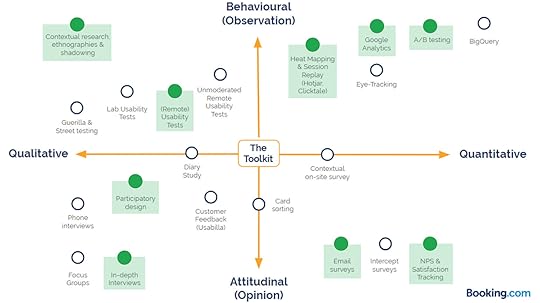 Use qualitative and quantitative research methods to generate better intelligence
Use qualitative and quantitative research methods to generate better intelligenceMost growth coaches advise you to focus on the number of insights generated in the early stages of your GTM. This can mean doing more interviews and surveys for customer validation. However, I encourage you to presell or at least get letters of commitment with recommendations because
people say < people do
(confidence = evidence)
Rapid experimentation is a good thing. The BIG QUESTION is:
Why do most companies fail to experiment fast (enough)?
Let’s investigate three possible reasons and find ways to overcome them. ✌️
(spoiler: no one lacks ideas for experiments)
1) 🐘Look for a Single Source of TruthThe larger the organization, the more likely you’ll find its people trying to identify business challenges and opportunities in a disconnected way. It’s like a bunch of blindfolded people attempting to identify an animal by touch.
 Everyone has sound logic, but no one is right
Everyone has sound logic, but no one is rightOne of my scaling clients (bagged +$40million funding) told me:
“A company is a truth-seeking entity.”
In this quest for truth, companies must ideally look for a “single source of truth”. But usually, this is an aspiration, not a reality.
The reality consists of many fragmented views, data sources and software that produce trackbacks, vendor-reported metrics, and expert opinions.
There are multiple versions of truths flowing through multiple streams. This creates confusion and misalignment of efforts.
For instance, you’ll have different challenges to answer the question: Why is the ROI low on this campaign?
💥 Shit - the influencer did not use the UTM link
💥 The conversion metrics between Meta Business and Google Analytics are different
💥 For some reason, there are more activated than registered users 🤯
How to make sense of this?
The only solution is to agree on an analytical system, which fetches data from multiple systems, and implement it across the organization. People must look at the same data in real time.
For analytics, I like to work backward - first, I create a mock-up of the dashboard I would like to see as a decision-maker. Next, I connect different data streams to the dashboard to centralize decision-making intelligence.
2) If a Metric Does Not Impact Your Behavior - Delete it!The FOMO associated with the approach of “we should measure everything” has its right place in backend processes, not in a dashboard that I use for intelligence in my decision-making.
Here are some metrics that B2B SaaS often use to guide their go-to-market efforts:
1. Monthly Recurring Revenue (MRR) and Annual Recurring Revenue (ARR)
Why it matters: These metrics are the cornerstone of SaaS financial performance, providing a clear picture of predictable, recurring income.
What to track: Track new MRR, expansion MRR (upsells), contraction MRR (downgrades), and churned MRR to understand the dynamics of your revenue growth.
2. Customer Acquisition Cost (CAC)
Why it matters: CAC quantifies the cost of acquiring a new customer, helping evaluate the efficiency of sales and marketing investments.
What to track: Divide the total costs of acquiring customers (e.g., marketing spend, sales team expenses) by the number of new customers acquired during a specific period.
3. Customer Lifetime Value (LTV)
Why it matters: LTV helps measure the long-term profitability of a customer, offering insights into the value of your user base and justifying your CAC investments.
What to track: Calculate LTV by multiplying the average revenue per user (ARPU) by the customer lifespan, while factoring in churn rates.
4. Churn Rate (Customer and Revenue)
Why it matters: Churn measures the rate at which customers or revenue are lost, providing insight into the health of customer relationships and the value of your product.
What to track: Monitor both customer churn (percentage of customers lost) and revenue churn (percentage of revenue lost), ideally separately for gross and net churn.
5. Net Revenue Retention (NRR)
Why it matters: NRR reflects the total revenue retained from existing customers, accounting for renewals, upsells, cross-sells, and churn. High NRR (above 100%) indicates that your business can grow revenue without relying solely on new customer acquisition.
6. Pipeline Velocity
Why it matters: This metric shows how efficiently leads move through the sales funnel, from initial interest to closed deals, offering a snapshot of sales effectiveness.
What to track: Combine the number of qualified leads, win rate, average deal size, and sales cycle length.
7. Product Engagement Metrics
Why it matters: SaaS companies need to know if their product delivers value. Metrics like activation rate, feature adoption, and monthly active users (MAU) indicate how well customers engage with the product.
What to track: Identify key usage metrics tied to value delivery, such as time-to-value or the percentage of users reaching onboarding milestones.
8. Sales Efficiency (e.g., Magic Number)
Why it matters: Sales efficiency KPIs show how well your sales and marketing efforts translate into revenue growth. The Magic Number compares the increase in ARR to sales and marketing spend.
What to track: A Magic Number above 1 indicates efficient sales growth.
9. Customer Satisfaction Metrics
Why it matters: Happy customers are more likely to renew and advocate for your product. Metrics like Net Promoter Score (NPS) and Customer Satisfaction (CSAT) provide qualitative insights into the customer experience.
What to track: Regularly survey customers to gauge satisfaction and identify improvement areas.
10. Cash Runway and Burn Rate
Why it matters: For SaaS startups or scaling businesses, cash flow management is critical. Burn rate and cash runway indicate financial health and sustainability.
What to track: Monitor monthly operating costs and remaining capital to project how long the business can operate without additional funding.
Tracking these KPIs provides B2B SaaS companies with the insights needed to drive growth, optimize operations, and foster customer loyalty, ensuring long-term success.
Beginner: If you don’t know which metrics to display on your dashboard, check out this beautiful moodboard for inspiration. Growth and product legends such as Elena Verna, Kyle Poyar, Ben Williams, Leah Tharin, and many other experts have pitched in with FREE templates for almost any tech product business model you can think of.
 Amplitude published one of the best dashboard galleries out there; see what applies to you
Amplitude published one of the best dashboard galleries out there; see what applies to youPRO: If you want to learn how digitally mature companies grow revenue more quickly, this new Guide to Growth by Amplitude is for you. It offers actionable best practices and real-world insights from global organizations like Appfire, SafetyCulture, MoEngage, Unity, and more. With nearly 70% of digital transformation initiatives failing, these lessons provide a practical roadmap to avoid the pitfalls.
 Learn from practical examples how companies prepare the terrain to scale3) 🌾Break the Silos 🔨: How to Organize a Team
Learn from practical examples how companies prepare the terrain to scale3) 🌾Break the Silos 🔨: How to Organize a TeamAfter you secure a ‘single source of truth’ - you bump into another challenge - PEOPLE.
Who is responsible and who will do the actual work?
The larger organizations I work with have growth teams. They mainly pick from the three models:
Centralized aka internal agency: One growth team serving multiple business units
Decentralized: Multiple growth teams supporting different business units
Center of Excellence aka “team of teams”: You have a growth team as a standalone department serving different business units and formulating growth teams within them.
In even larger organizations, you have multiple growth teams specializing in different parts of the funnel such as acquisition, retention, and monetization. They operate as teams of teams.
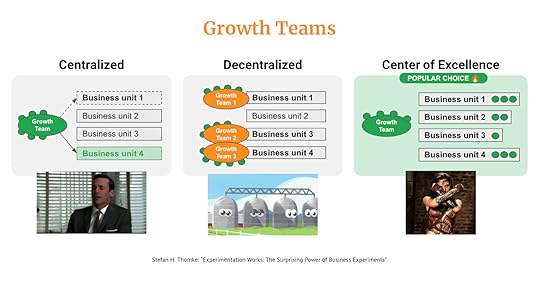 There are different ways to structure a growth team
There are different ways to structure a growth teamBelow is an example of what a Center of Excellence growth team looks like for a finance media company.
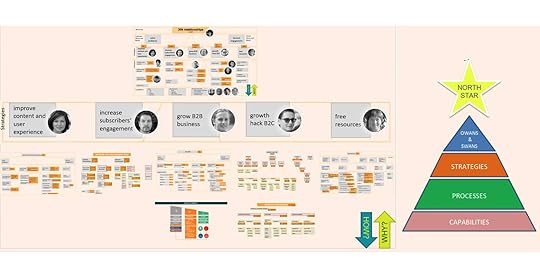 Adjusted from Bonnier’s Media Growth team Finance
Adjusted from Bonnier’s Media Growth team FinanceI wish I could give you really clever HR-grade advice on who should be in the growth team,but my “street smart” answer is: Those who have the knowledge, respect, influence, and experience to get the work done + they share your vision of a culture of experimentation.
However, you must assign people to growth teams only after modifying their OKRs and rewards to reflect that. Otherwise it could demotivate them.
Still, we must address one more silo - vendors, freelancers and agencies. Companies seek external help with implementation, and these external agents create another silo. Ideally, you must work with vendors to achieve the company's goals.
But you and I both know that it’s hard to get external vendors (who are potential competitors) to work with each other.
The best you can do is to assign an external owner to agency relationships and compare their reports to the single source of truth you created to hold them accountable.
Most good strategies fail because of poor execution, not poor planningNow you can have the best analytical system and the most competent and driven cross-departmental team. But the attempt to be a “data-driven and experiment-led growth machine” could still fail if it is not managed and executed properly.
For that you need standard operating procedures(SOPs). Here are some of the best practices for plan execution I have seen on the field, largely influenced by Sean Ellis’s teaching 🙏:
Agree on North Star Metric
Determinate quarterly or monthly objectives (a maximum of 3, if you are new to this)
Select a growth team (comprising leads, platform specialists, channel specialists, and analysts)
Make the team work weekly or biweekly sprints
Create an experiment pool (backlog)
Agree on a prioritization method
Run a growth meeting (agenda below)
After that you do a retrospective meeting
 Adjusted from Sean Ellis + real example
Adjusted from Sean Ellis + real exampleEasy? No.
Worth it? Yes.
If you operate in a complex environment, you can’t bypass the issues of “being data driven” across vision, processes, and technology. See how 5 scaleup companies tackled this problem and built healthy environments for experimentations and unified digital experience for their users.
Get Amplitude’s “Guide to Growth”
🍭 Goodie bagYesterday, I launched an MVI - minimal viable idea 🤠of our first attempt of LMS (chatbot 🤖) I trained it on 1 million characters of my priority content - have fun breaking it!
My friends at SaaS Pricing issued a new 2024 AI SaaS pricing report. You can access it here for free: https://pricingsaas.com/benchmarksAI/
On Monday, 23 December, Product Management expert Jason Knight (One Knight in Product) and I will go live on LinkedIn and YouTube in our Christmas outfits 🧑🎄 - if you have some questions, hop on and we will make it interesting.
Are you ready to dive deeper and work on your Go-To-Market strategy and execution?Discover my solutions that support your journey from launching to scaling:
🛰️ Explorer: Understand Go-To-Market and develop a winning GTM plan.
Get best selling GTM Strategist book + 20 frameworks (workshops) + online course ($47). Tested by 7500+ companies
🚀 Doer: Leverage the 100-step GTM Checklist tested on 750+ launches with templates (emails, launch plans, posts, landing pages), which will guide you from getting ready to launch to an impactful launch and scaling stage.
Get the Checklist ($97)
💫 Leader: Guide your team to successfully choose ICP (target market), pricing, positioning & selection of best GTM Motion (channels, tactics). GTM Bootcamp includes 5 hours of applicable videos and a personal Miro board.
Get the Bootcamp ($347)
December 13, 2024
Goals and Objectives are Your GTM Compass
In this post, you will learn:
How to set the right metrics for your go-to-market strategy
How to find your North Star Metric with a new framework
How to ensure that you measure what matters

This post is sponsored by Amplitude. Apart from delivering the best analytics platform for product and marketing teams, they are also opinion leaders in this space and publish top-notch guides. Amplitude just dropped a revamped version of the North Star Playbook. Get it here.
With 2025 almost here, we are all shaping our strategies and plans for the year to come. The important plan of any plan is how to measure it. In this post, I will guide you on how to choose your top metric (your goal) and how to know that you are on the right track while getting there.
To ensure you’re highly likely to achieve the goal you’ve set and are monitoring regularly, it’s important to carefully choose which goal to pursue.
You all know that goals should be smart, right?
S - Specific
M - Measurable
A - Attainable
R - Relevant
T - Time-based
Now, here is your tactical guide on how to select mission-critical objectives and metrics that will guide your actions.
Let’s first look at my business's example to help us understand the key concepts.
Mindset: Allow yourself to think BIG 🎯If you can dream it - you can achieve it.
The key question is: what do you want to achieve?
Oftentimes, when I talk to founders, they are shy about this.
But no need to be shy - because most people will work like a horse for 6-12 months for an “incremental improvement”. You need to think bigger.
You need something that will excite you.
That will motivate your team.
That will make you proud.
The questions that I ask myself every single day are:
“What would 10x this business”.
If I am feeling visionary, even 100x.
The key difference is that I have to believe it. Feel it.
As if it is your calling and you are on a mission.
While it is very unlikely that I am building the next Apple here, it is perfectly reasonable to challenge myself - what would have to be true that this would become a 10 million business?
That I can imagine.
And I am eager to figure it out.
It is the next frontier that I want to conquer.
This way of thinking will help me optimize my decisions in the long run - to choose “the game”, the business model that I am playing.
Yes, it can be a bit scary, some would say delusional, and really hard to tackle - but it makes ALL the difference.
Now, back to reality … What can I do NOW - this year, this quarter - to make a step towards that direction?
Most people usually underestimate what they can do in 3-5 years and overestimate what they can do in a year.
Even if your “vision” comes to life in 3-5 years instead of a year, you are still likely to achieve more than people who do not even dare to dream a little.
After you shake hands with yourself and with the team to agree on what you can do in a year - make it a written commitment.
When I was launching GTM Strategist, it was mission-critical to sell 2000 copies in the first month.
How did I get this number?
I took some historical data from colleagues on how many copies they had to see at launch to make an Amazon best-seller. Then I rounded up the number “just to be safe” if some whale was launching on the same day.
From then on - we were “mission critical 🎯 = selling 2000 copies”
It was a key piece of alignment that we needed for the launch.
Everyone could use this prism to make the right shots.
If you operate like this, it is more a question of WHEN than IF you will do it.
It is tough to beat a person on a mission.
You will find ways to make it happen.
Now, a super honest conversation: what is the worst thing that could happen if I failed this?
I would still sell like 500 units because I will do the work …
…well that is 5X the case if I would set myself a modest vanilla goal such as selling 100 copies.
That is too easy. And easy is the enemy of great.
The next question is: how to get there?
For me, 1-page marketing plan often comes to the rescue. Here is how I thought about the business I am working hard to build last year:
 This was an early “business model” I envisioned in 2023 - most of the assumptions were validated
This was an early “business model” I envisioned in 2023 - most of the assumptions were validatedAs 🎯mission critical = sell 2000 copies objective was done, I did not want to leave the team in a vacuum. We needed a “bigger purpose” - something that would capture the essence of value that our ecosystem is providing.
And I set up my first North Star Metric (more info later) that I keep on using today:
BIG vision: Help 10,000 a year to cross the chasm with GTM Strategist method.
This was probably one of the best decisions I made last year so the team did not end up in a vacuum and existential crisis of the absence of an objective after we achieved our mission critical. We need to know immediately what our next hill to conquer is.
More importantly, the buy-in from the team was even stronger.
How could it not be - to sell X amount of something secured our lifeline, but now we are on a mission to help, to make an impact. For most, that is a better motivation.
Now - YOU time.
How can you use this powerful alignment mechanism in your business?
Bottom-line metrics vs. North Star MetricWhen shaping a go-to-market strategy, you need to understand the distinction between bottom-line metrics and the North Star Metric (NSM). As Sean Ellis wrote, the North Star Metric is the single metric that best captures the core value that your product delivers to customers. When you optimize your efforts to grow your NSM, it drives sustainable growth across your entire customer base.
Bottom-line metrics focus on financial outcomes that demonstrate your company’s overall health and profitability—think revenue, profit margins, or cash flow. These metrics provide a snapshot of whether your business is thriving, making them essential for financial planning, for investors, board members, and other stakeholders. However, while crucial, bottom-line metrics often reflect past performance rather than driving future growth.
In contrast, the North Star Metric serves as a unifying, forward-looking guide. It represents the one metric that best captures the core value a company delivers to its customers.
For example, a subscription-based service might focus on "weekly active users” because someone who regularly uses the service signals customer satisfaction and retention.
Another benefit of the NSM is that it aligns cross-functional teams, helping them focus on activities that directly impact sustainable growth. Marketing, sales, product, customer service, and other teams should think about how they can contribute to improving the NSM with their actions. In the case of “weekly active users”, marketing by communicating the value to the right users, the product team by improving the product, and so on.
The interplay between the bottom-line metrics and NSM is crucial for success. Bottom-line metrics measure the outcome of actions driven by the NSM. By focusing on the North Star Metric, teams ensure their efforts create meaningful value for customers, which ultimately fuels the bottom line.
In short, you need to make sure that you also monetize and capture some of the value you deliver to your customers - so that your NSM is correlated with the bottom-line metrics such as revenue and profit.
Which game are you playing?Amplitude researched more than 11,000 companies and 3 trillion user actions. They have learned that all digital products are playing one of three possible games:
The Attention Game: How much of your customers’ time can you capture in your product?
The Transaction Game: How many commercial transactions does your user make on your platform?
The Productivity Game: How many high-value digital tasks can your customer perform in your product?
Here are some examples of NSM and the “games” from well-known tech companies, as prepared by Paweł Huryn from The Product Compass:
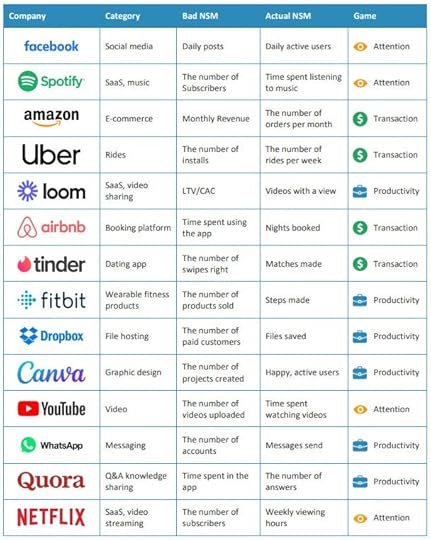 Source: The Product CompassHow to define your North Star Metric?
Source: The Product CompassHow to define your North Star Metric?Amplitude just published a revamped version of their North Star Playbook with more than 60 pages of actionable advice from top experts.
I especially like this North Star statement exercise that will guide you toward defining the NSM that will work for you:
 Get the full template here
Get the full template hereIf you want to dive deeper, here is a guide to discovering your product’s North Star by Amplitude: https://amplitude.com/resources/north-star-playbook
North Star Metric vs. One Metric That MattersWhen setting on a go-to-market journey, finding the perfect North Star Metric (NSM) can seem like a good-to-do, not mission-critical thing. And I get it - if you don’t even know if you have a business, go all-in on the metric that will “keep the lights on”- a short-term One Metric That Matters (OMTM) and worry about your North Star Metric later.
OMTM keeps your business operational and focused during the critical early stages, bridging the gap until you can establish a more comprehensive North Star Metric. It's about strategic adaptability and laser-focused execution when resources are limited.
By examining case studies from companies like Amplitude, Canva, Patreon, and smaller ventures like M1 Project, Zebra BI, and Growth Lab, I've concluded that while a North Star Metric is an excellent strategic guide post-product-market fit, the OMTM is crucial for survival and initial momentum.
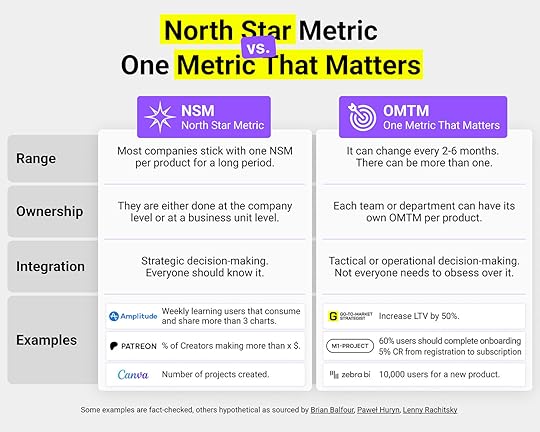
To measure North Star Metric correctly, you must also have a sound analytics system. In my case, the NSM of “getting 10,000 businesses across the chasm” could not be accurately defined before I started to sell the digital products through my platform and collected feedback from readers - did they really implement this?
In all honesty, I cannot claim that I helped someone “to cross the chasm and reach early majority” if they liked my LinkedIn status 🙈- my team would laugh if I pitched this proxy.
Now go, go, go and implement this!
What is your mission-critical objective for 2025, and what could be your North Star Metric that measures the value created in your ecosystem? Download Amplitude’s North Star Metric report if you need more insights on defining NSM 🌠 and remember to write your objectives down.
According to bro science on LinkedIn, written objectives are 42% more likely to be achieved 🤠
But seriously, do it because it is good for you and your team.
Are you ready to dive deeper and work on your Go-To-Market strategy and execution?Discover my solutions that support your journey from launching to scaling:
[BESTSELLER] 🏆 Ready to win: Tackle the most pressing Go-to-Market issues such as selection of ICP, positioning, how to get customers, build teams and select proven ways how to go to market. Book a 90-minute hands-on consultation with Maja, get personalized guidance, a Miro board, and reliable vendor contacts for further work.
Want to bullet-proof your 2025 strategy? Book a session ($500)
🛰️ Explorer: Understand Go-To-Market and develop a winning GTM plan.
Get best selling GTM Strategist book + 20 frameworks (workshops) + online course ($47). Tested by 7500+ companies
🚀 Doer: Leverage the 100-step GTM Checklist tested on 750+ launches with templates (emails, launch plans, posts, landing pages), which will guide you from getting ready to launch to an impactful launch and scaling stage.
Get the Checklist ($97)
💫 Leader: Guide your team to successfully choose ICP (target market), pricing, positioning & selection of best GTM Motion (channels, tactics). GTM Bootcamp includes 5 hours of applicable videos and a personal Miro board.
Get the Bootcamp ($347)



